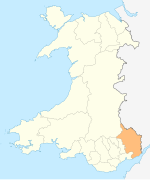Grade II* listed buildings in Monmouthshire: Difference between revisions
m typographical changes (formatting units, no whitespace before "note 1", typo, consistent formatting of "Additional references") |
|||
| Line 3: | Line 3: | ||
{{GeoGroup}} |
{{GeoGroup}} |
||
[[Monmouthshire]] is a [[Local government in Wales|county]] and [[Local government in Wales#Principal areas of Wales|principal area]] of Wales. It borders [[Torfaen]] and [[Newport, Wales|Newport]] to the west; [[Herefordshire]] and [[Gloucestershire]] to the east; and [[Powys]] to the north. The largest town is [[Abergavenny]], with the other major towns being [[Chepstow]], [[Monmouth]], and [[Usk]].{{sfn|Evans|1953|p=29}} The county is 850 |
[[Monmouthshire]] is a [[Local government in Wales|county]] and [[Local government in Wales#Principal areas of Wales|principal area]] of Wales. It borders [[Torfaen]] and [[Newport, Wales|Newport]] to the west; [[Herefordshire]] and [[Gloucestershire]] to the east; and [[Powys]] to the north. The largest town is [[Abergavenny]], with the other major towns being [[Chepstow]], [[Monmouth]], and [[Usk]].{{sfn|Evans|1953|p=29}} The county is {{val|850|u=km2}} (330 sq mi) in extent,<ref>{{Cite web|url=https://www.britannica.com/place/Monmouthshire|title=Monmouthshire – History, Facts, & Points of Interest|website=Encyclopedia Britannica|accessdate=30 July 2019}}</ref> with a population of 93,600.<ref>{{Cite web|url=http://population.city/united-kingdom/monmouthshire/|title=Monmouthshire Population|website=population.city|accessdate=19 July 2019}}</ref> The present county was formed under the [[Local Government (Wales) Act 1994]], and comprises some sixty percent of the [[Monmouthshire (historic)|historic county]].<ref>{{Cite web|url=https://api.parliament.uk/historic-hansard/commons/1972/jul/20/clause-256|title=Clause 256 (Hansard, 20 July 1972)|publisher=HMSO|website=api.parliament.uk|accessdate=30 July 2019}}</ref> Between 1974 and 1996, the county was known by the ancient title of [[Gwent (county)|Gwent]],{{sfn|Clark|1979|p=207}} recalling the medieval Welsh [[Kingdom of Gwent|kingdom]].{{sfn|Clark|1980|p=42}} In his essay on local government in the fifth and final volume of the ''Gwent County History'', Robert McCloy suggests that the governance of "no county in the United Kingdom in the twentieth century was so transformed as that of Monmouthshire".{{sfn|McCloy|2013|p=126}} |
||
The term "listed building" in the United Kingdom refers to a building or structure officially designated of special architectural, historical or cultural significance. Listing was begun by a provision in the [[Town and Country Planning Act 1947]]. Once a building is listed, strict limitations are imposed on allowable modifications to its structure or fittings. In Wales,<ref>{{cite web|url=http://www.coflein.gov.uk|title=Coflein|work=online database of RCAHMW|publisher=[[Royal Commission on the Ancient and Historical Monuments of Wales]]|accessdate=28 November 2016|archive-url=https://web.archive.org/web/20161127035431/http://www.coflein.gov.uk/|archive-date=27 November 2016|url-status=live}}</ref> the authority for listing under the [[Planning (Listed Buildings and Conservation Areas) Act 1990]]<ref>{{Cite web|url=http://www.legislation.gov.uk/ukpga/1990/9/contents|title=Planning (Listed Buildings and Conservation Areas) Act 1990|publisher=The National Archives|accessdate=18 June 2013|archive-url=https://www.webcitation.org/6DusMFk5C?url=http://www.legislation.gov.uk/ukpga/1990/9/contents|archive-date=24 January 2013|url-status=live}}</ref> rests with [[Cadw]]. Listed buildings are categorised into three grades: |
The term "listed building" in the United Kingdom refers to a building or structure officially designated of special architectural, historical or cultural significance. Listing was begun by a provision in the [[Town and Country Planning Act 1947]]. Once a building is listed, strict limitations are imposed on allowable modifications to its structure or fittings. In Wales,<ref>{{cite web|url=http://www.coflein.gov.uk|title=Coflein|work=online database of RCAHMW|publisher=[[Royal Commission on the Ancient and Historical Monuments of Wales]]|accessdate=28 November 2016|archive-url=https://web.archive.org/web/20161127035431/http://www.coflein.gov.uk/|archive-date=27 November 2016|url-status=live}}</ref> the authority for listing under the [[Planning (Listed Buildings and Conservation Areas) Act 1990]]<ref>{{Cite web|url=http://www.legislation.gov.uk/ukpga/1990/9/contents|title=Planning (Listed Buildings and Conservation Areas) Act 1990|publisher=The National Archives|accessdate=18 June 2013|archive-url=https://www.webcitation.org/6DusMFk5C?url=http://www.legislation.gov.uk/ukpga/1990/9/contents|archive-date=24 January 2013|url-status=live}}</ref> rests with [[Cadw]]. Listed buildings are categorised into three grades: |
||
| Line 10: | Line 10: | ||
* Grade II – buildings of special interest; 91.7% of all listed buildings in England and Wales are in this class.<ref>{{Cite web |url=https://historicengland.org.uk/listing/what-is-designation/listed-buildings/ |title=What is Listing?|publisher=Historic England|access-date=2019-07-19 |archive-url=https://www.webcitation.org/6oxwrgTpU?url=https://historicengland.org.uk/listing/what-is-designation/listed-buildings/ |archive-date=2017-03-14 |url-status=live }}</ref> |
* Grade II – buildings of special interest; 91.7% of all listed buildings in England and Wales are in this class.<ref>{{Cite web |url=https://historicengland.org.uk/listing/what-is-designation/listed-buildings/ |title=What is Listing?|publisher=Historic England|access-date=2019-07-19 |archive-url=https://www.webcitation.org/6oxwrgTpU?url=https://historicengland.org.uk/listing/what-is-designation/listed-buildings/ |archive-date=2017-03-14 |url-status=live }}</ref> |
||
There are 244 Grade II* listed buildings in Monmouthshire.<ref>{{cite web|url=http://www.britishlistedbuildings.co.uk/wales/monmouthshire/grade-iix#.WX2YkpJK19A|title=Grade II* Listed Buildings in Monmouthshire|author=British Listed Buildings online|website=www.britishlistedbuildings.co.uk|access-date=2017-07-30|archive-url=https://web.archive.org/web/20170730150216/http://www.britishlistedbuildings.co.uk/wales/monmouthshire/grade-iix#.WX2YkpJK19A|archive-date=2017-07-30|url-status=live}}</ref> They include seventy-two houses, forty-two churches, thirty-five farmhouses, twenty-one commercial premises, eight bridges, seven barns, six garden structures, four sets of walls, railings or gates, three gatehouses, two chapels, two community centres, two dovecotes, an almshouse, an aqueduct, a castle, a courthouse, a cross, a dairy, a folly, a masonic lodge, a mill, a prison, a former slaughterhouse, a statue and a theatre. |
There are 244 Grade II* listed buildings in Monmouthshire.<ref>{{cite web|url=http://www.britishlistedbuildings.co.uk/wales/monmouthshire/grade-iix#.WX2YkpJK19A|title=Grade II* Listed Buildings in Monmouthshire|author=British Listed Buildings online|website=www.britishlistedbuildings.co.uk|access-date=2017-07-30|archive-url=https://web.archive.org/web/20170730150216/http://www.britishlistedbuildings.co.uk/wales/monmouthshire/grade-iix#.WX2YkpJK19A|archive-date=2017-07-30|url-status=live}}</ref> They include seventy-two houses, forty-two churches, thirty-five farmhouses, twenty-one commercial premises, eight bridges, seven barns, six garden structures, four sets of walls, railings or gates, three gatehouses, two chapels, two community centres, two dovecotes, an almshouse, an aqueduct, a castle, a courthouse, a cross, a dairy, a folly, a masonic lodge, a mill, a prison, a former slaughterhouse, a statue and a theatre.<ref group="note">There is not an exact match between the number of Grade II* listed buildings in Monmouthshire, (244), and the number of Wikipedia entries for these, (217). There are a number of reasons for this, including that some Wikipedia entries cover more than one listing, e.g. [[Castle Terrace, Chepstow]] covers thirteen listings, and that some single buildings or structures have more than one listing, e.g. [[New Bridge, Newbridge-on-Usk]] which, quite commonly for bridges, has listings for both ends.</ref> Monmouthshire's only Grade II* listed castle, [[Skenfrith Castle|Skenfrith]], forms the eastern point of the [[Three Castles]] triangle,{{sfn|Courtney|2008|p=53}} a grouping that remained in unified ownership from the reign of [[King Stephen of England|King Stephen]] until the 20th century.{{sfn|Kenyon|2010|p=141}} [[William Coxe (historian)|William Coxe]], in his 1801 history, described it as "the oldest castle in Monmouthshire".{{sfn|Coxe|1995b|p=331}} Architects of national importance who worked in the county include [[John Nash (architect)|John Nash]] and [[John Soane|Sir John Soane]], who made their respective marks at the [[Clytha Park|Clytha Park gates]]{{sfn|Newman|2000|p=190}} and the, now ruinous, [[Piercefield House]].{{sfn|Newman|2000|p=471}} [[Aston Webb|Sir Aston Webb]], who designed the present frontage of [[Buckingham Palace]], built on a less imposing scale at the [[Swiss Cottage, Rockfield]].{{sfn|Newman|2000|p=516}} The involvement of such national figures was rare; the county's major houses are predominantly modest dwellings built by the Welsh gentry,{{sfn|Newman|2009|p=332}} such as [[Lower Dyffryn House, Grosmont]], constructed by a cadet branch of the [[William Cecil, 1st Baron Burghley|Cecil family]].{{sfn|Newman|2000|p=244}} The "[[Neo-classical architecture|neo-classical]] monster",{{sfn|Newman|2000|pp=264–265}} [[Llanarth Court]], is exceptional in both scale and style, although not in its origins.{{sfn|Coxe|1995a|p=159}} The run of houses with commercial premises at street level, [[1–6 Priory Street, Monmouth]],{{sfn|Lewis|2011|p=116}} described by the architectural historian [[John Newman (architectural historian)|John Newman]] as "a remarkably early inner bypass", is by the Monmouthshire architect, [[George Vaughan Maddox]], whose work contributed much to the architectural "flavour" of the county town.{{sfn|Newman|2000|p=394}} The county's churches are predominantly [[Middle Ages|Medieval]], such as the [[St Cybi's Church, Llangybi, Monmouthshire|Church of St Cybi]] at [[Llangybi, Monmouthshire|Llangybi]].{{sfn|Knight|2004|p=277}} Exceptions include the [[Church of St Mary and St Michael, Llanarth]], the first Catholic chapel built in Monmouthshire since the [[Dissolution of the Monasteries]],{{sfn|Newman|2000|pp=265–266}} and [[St Mary's Priory Church, Monmouth]], by the Victorian architect, [[George Edmund Street]].{{sfn|Newman|2000|p=395}} |
||
<ref group="note">There is not an exact match between the number of Grade II* listed buildings in Monmouthshire, (244), and the number of Wikipedia entries for these, (217). There are a number of reasons for this, including that some Wikipedia entries cover more than one listing, e.g. [[Castle Terrace, Chepstow]] covers thirteen listings, and that some single buildings or structures have more than one listing, e.g. [[New Bridge, Newbridge-on-Usk]] which, quite commonly for bridges, has listings for both ends.</ref> Monmouthshire's only Grade II* listed castle, [[Skenfrith Castle|Skenfrith]], forms the eastern point of the [[Three Castles]] triangle,{{sfn|Courtney|2008|p=53}} a grouping that remained in unified ownership from the reign of [[King Stephen of England|King Stephen]] until the 20th century.{{sfn|Kenyon|2010|p=141}} [[William Coxe (historian)|William Coxe]], in his 1801 history, described it as "the oldest castle in Monmouthshire".{{sfn|Coxe|1995b|p=331}} Architects of national importance who worked in the county include [[John Nash (architect)|John Nash]] and [[John Soane|Sir John Soane]], who made their respective marks at the [[Clytha Park|Clytha Park gates]]{{sfn|Newman|2000|p=190}} and the, now ruinous, [[Piercefield House]].{{sfn|Newman|2000|p=471}} [[Aston Webb|Sir Aston Webb]], who designed the present frontage of [[Buckingham Palace]], built on a less imposing scale at the [[Swiss Cottage, Rockfield]].{{sfn|Newman|2000|p=516}} The involvement of such national figures was rare; the county's major houses are predominantly modest dwellings built by the Welsh gentry,{{sfn|Newman|2009|p=332}} such as [[Lower Dyffryn House, Grosmont]], constructed by a cadet branch of the [[William Cecil, 1st Baron Burghley|Cecil family]].{{sfn|Newman|2000|p=244}} The "[[Neo-classical architecture|neo-classical]] monster",{{sfn|Newman|2000|pp=264–265}} [[Llanarth Court]], is exceptional in both scale and style, although not in its origins.{{sfn|Coxe|1995a|p=159}} The run of houses with commercial premises at street level, [[1–6 Priory Street, Monmouth]],{{sfn|Lewis|2011|p=116}} described by the architectural historian [[John Newman (architectural historian)|John Newman]] as "a remarkably early inner bypass", is by the Monmouthshire architect, [[George Vaughan Maddox]] whose work contributed much to the architectural "flavour" of the county town.{{sfn|Newman|2000|p=394}} The county's churches are predominantly [[Middle Ages|Medieval]], such as the [[St Cybi's Church, Llangybi, Monmouthshire|Church of St Cybi]] at [[Llangybi, Monmouthshire|Llangybi]].{{sfn|Knight|2004|p=277}} Exceptions include the [[Church of St Mary and St Michael, Llanarth]], the first Catholic chapel built in Monmouthshire since the [[Dissolution of the Monasteries]],{{sfn|Newman|2000|pp=265–266}} and [[St Mary's Priory Church, Monmouth]], by the Victorian architect, [[George Edmund Street]].{{sfn|Newman|2000|p=395}} |
|||
Notable people connected with Monmouthshire's Grade II* listed buildings include the Catholic martyr [[David Lewis (Jesuit priest)|David Lewis]] who was imprisoned at [[30 Bridge Street, Usk]] prior to his execution in 1679; [[Horatio Nelson, 1st Viscount Nelson|Lord Nelson]], whose tour down that "little gut of a river, the Wye",{{sfn|Kissack|1975|p=251}} is commemorated in a pavilion in the [[Nelson Garden]] in Monmouth;{{sfn|Newman|2000|p=408}} the aviation and motoring pioneer, [[Charles Stewart Rolls]], the first Briton to die in a plane crash, who lived at [[The Hendre]], Monmouthshire's "only full-scale Victorian country house",{{sfn|Newman|2000|p=247}} and whose [[Statue of Charles Rolls, Monmouth|statue]] stands in Agincourt Square;{{sfn|Newman|2000|p=402}} and [[Winston Churchill]], whose predecessors lived at [[Trewyn House]] in the north of the county.{{sfn|Hando|1954|p=40}} For over two hundred years, the [[Dukes of Beaufort]] directed the management of their extensive Monmouthshire estates, and the political life of the county, from their seat at [[Troy House]].{{sfn|Kissack|1986|p=2}}{{sfn|Benson|2017|p=4}} [[FitzRoy Somerset, 1st Baron Raglan]] received [[Cefntilla Court]] in recognition of his services as the British commander during the [[Crimean War]];{{sfn|Newman|2000|p=272}} and the writer and gardener, [[Henry Avray Tipping]] built two houses for himself, at [[Mounton House|Mounton]] and at [[High Glanau]].{{sfn|Newman|2000|p=208}} [[John Loraine Baldwin]], a founder of the cricket club |
Notable people connected with Monmouthshire's Grade II* listed buildings include the Catholic martyr [[David Lewis (Jesuit priest)|David Lewis]] who was imprisoned at [[30 Bridge Street, Usk]] prior to his execution in 1679; [[Horatio Nelson, 1st Viscount Nelson|Lord Nelson]], whose tour down that "little gut of a river, the Wye",{{sfn|Kissack|1975|p=251}} is commemorated in a pavilion in the [[Nelson Garden]] in Monmouth;{{sfn|Newman|2000|p=408}} the aviation and motoring pioneer, [[Charles Stewart Rolls]], the first Briton to die in a plane crash, who lived at [[The Hendre]], Monmouthshire's "only full-scale Victorian country house",{{sfn|Newman|2000|p=247}} and whose [[Statue of Charles Rolls, Monmouth|statue]] stands in Agincourt Square;{{sfn|Newman|2000|p=402}} and [[Winston Churchill]], whose predecessors lived at [[Trewyn House]] in the north of the county.{{sfn|Hando|1954|p=40}} For over two hundred years, the [[Dukes of Beaufort]] directed the management of their extensive Monmouthshire estates, and the political life of the county, from their seat at [[Troy House]].{{sfn|Kissack|1986|p=2}}{{sfn|Benson|2017|p=4}} [[FitzRoy Somerset, 1st Baron Raglan]] received [[Cefntilla Court]] in recognition of his services as the British commander during the [[Crimean War]];{{sfn|Newman|2000|p=272}} and the writer and gardener, [[Henry Avray Tipping]] built two houses for himself, at [[Mounton House|Mounton]] and at [[High Glanau]].{{sfn|Newman|2000|p=208}} [[John Loraine Baldwin]], a founder of the cricket club [[I Zingari]] and author of the rules of both [[badminton]] and [[whist]], lived at [[St Anne's House, Tintern]].<ref>{{Cite web|url=http://www.espncricinfo.com/wisdenalmanack/content/story/227102.html|title=Obituaries in 1897|date=November 24, 2005|publisher=Wisden|access-date=1 September 2019|website=Cricinfo}}</ref> The [[Victorian era|Victorian]] poet [[Cecil Frances Alexander]] was reputed to have been inspired to write the hymn, ''[[All Things Bright and Beautiful]]'' by the countryside around [[Llanwenarth House]].<ref>{{Cite web|url=http://www.walesonline.co.uk/news/wales-news/all-things-bright-beautiful-mansion-9132182|title=Millionaire mansion owner admits illegal work on Grade II property|first=Martin|last=Shipton|date=April 27, 2015|publisher=Wales Online|website=walesonline|access-date=1 September 2019}}</ref> |
||
The architecture of the county was first systematically covered by William Coxe in his two-volume, ''An Historical Tour in Monmouthshire'', published in 1801. A detailed county history was undertaken by [[Joseph Bradney|Sir Joseph Bradney]], in his ''[[A History of Monmouthshire from the Coming of the Normans into Wales down to the Present Time]]''; published in the early 20th century.{{sfn|Bradney|1991|loc=preface}} More recent studies include those of the architectural historian [[John Newman (architectural historian)|John Newman]], in his ''Gwent/Monmouthshire'' volume of the [[Pevsner Architectural Guides|Pevsner Buildings of Wales series]]; and, most exhaustively, by [[Cyril Fox|Sir Cyril Fox]] and [[FitzRoy Somerset, 4th Baron Raglan|Lord Raglan]], in their three-volume study, ''[[Monmouthshire Houses]]''.{{sfn|Fox|Raglan|1994|loc=preface}} The last was described by the architectural historian [[Peter Smith (architectural historian)|Peter Smith]] as "one of the most remarkable studies of vernacular architecture yet made in the British Isles,{{sfn|Smith|1975|p=7}} a landmark, in its own field, as significant as [[Charles Darwin|Darwin's]] ''[[Origin of Species]]''".{{sfn|Newman|2000|p=84}} |
The architecture of the county was first systematically covered by William Coxe in his two-volume, ''An Historical Tour in Monmouthshire'', published in 1801. A detailed county history was undertaken by [[Joseph Bradney|Sir Joseph Bradney]], in his ''[[A History of Monmouthshire from the Coming of the Normans into Wales down to the Present Time]]''; published in the early 20th century.{{sfn|Bradney|1991|loc=preface}} More recent studies include those of the architectural historian [[John Newman (architectural historian)|John Newman]], in his ''Gwent/Monmouthshire'' volume of the [[Pevsner Architectural Guides|Pevsner Buildings of Wales series]]; and, most exhaustively, by [[Cyril Fox|Sir Cyril Fox]] and [[FitzRoy Somerset, 4th Baron Raglan|Lord Raglan]], in their three-volume study, ''[[Monmouthshire Houses]]''.{{sfn|Fox|Raglan|1994|loc=preface}} The last was described by the architectural historian [[Peter Smith (architectural historian)|Peter Smith]] as "one of the most remarkable studies of vernacular architecture yet made in the British Isles,{{sfn|Smith|1975|p=7}} a landmark, in its own field, as significant as [[Charles Darwin|Darwin's]] ''[[Origin of Species]]''".{{sfn|Newman|2000|p=84}} |
||
| Line 347: | Line 346: | ||
| {{gbmappingsmall|ST5281095680}}<br />{{Coord|51.657939286602|-2.6835931007269|format=dms|display=inline|name={{#invoke:Delink|delink|[[Piercefield House]]}} }} |
| {{gbmappingsmall|ST5281095680}}<br />{{Coord|51.657939286602|-2.6835931007269|format=dms|display=inline|name={{#invoke:Delink|delink|[[Piercefield House]]}} }} |
||
| House |
| House |
||
| About 1000m to the north east of the Lion Gates at the roundabout where the A466 crosses the B4293, the central block and the West and East pavilions have separate listings<ref>{{National Historic Assets of Wales|num=2013|desc=Piercefield House|access-date=2 August 2019}}</ref><br/>Additional reference numbers:<ref>{{National Historic Assets of Wales|num=24754|desc=West Pavilion, Piercefield House|access-date=2 August 2019}}</ref> |
| About 1000m to the north east of the Lion Gates at the roundabout where the A466 crosses the B4293, the central block and the West and East pavilions have separate listings<ref>{{National Historic Assets of Wales|num=2013|desc=Piercefield House|access-date=2 August 2019}}</ref><br/>Additional reference numbers:<ref>{{National Historic Assets of Wales|num=24754|desc=West Pavilion, Piercefield House|access-date=2 August 2019}}</ref><ref>{{National Historic Assets of Wales|num=24755|desc=East Pavilion, Piercefield House|access-date=2 August 2019}}</ref> |
||
| [http://cadwpublic-api.azurewebsites.net/reports/listedbuilding/FullReport?lang=en&id=2013 2013] |
| [http://cadwpublic-api.azurewebsites.net/reports/listedbuilding/FullReport?lang=en&id=2013 2013] |
||
| [[File:Piercefield House Chepstow.jpg|150x150px|[[Piercefield House]]]] |
| [[File:Piercefield House Chepstow.jpg|150x150px|[[Piercefield House]]]] |
||
| Line 967: | Line 966: | ||
| {{gbmappingsmall|SO5080812931}}<br />{{Coord|51.812860433322|-2.7149763340807|format=dms|display=inline|name={{#invoke:Delink|delink|[[The White Swan Inn, Monmouth|White Swan Inn]]}} }} |
| {{gbmappingsmall|SO5080812931}}<br />{{Coord|51.812860433322|-2.7149763340807|format=dms|display=inline|name={{#invoke:Delink|delink|[[The White Swan Inn, Monmouth|White Swan Inn]]}} }} |
||
| Commercial |
| Commercial |
||
| Part of the group on the principal street leading north and east from the town square and accessed between Nos.4 & 5<ref>{{National Historic Assets of Wales|num=2321|desc=White Swan Inn|access-date=2 August 2019}}</ref> |
| Part of the group on the principal street leading north and east from the town square and accessed between Nos. 4 & 5<ref>{{National Historic Assets of Wales|num=2321|desc=White Swan Inn|access-date=2 August 2019}}</ref> |
||
| [http://cadwpublic-api.azurewebsites.net/reports/listedbuilding/FullReport?lang=en&id=2321 2321] |
| [http://cadwpublic-api.azurewebsites.net/reports/listedbuilding/FullReport?lang=en&id=2321 2321] |
||
| [[File:White Swan Court, Monmouth.JPG|150x150px|[[The White Swan Inn, Monmouth|White Swan Inn]]]] |
| [[File:White Swan Court, Monmouth.JPG|150x150px|[[The White Swan Inn, Monmouth|White Swan Inn]]]] |
||
| Line 1,007: | Line 1,006: | ||
| {{gbmappingsmall|SO2915113947}}<br />{{Coord|51.81966|-3.02929|format=dms|display=inline|name={{#invoke:Delink|delink|[[Abergavenny Bridge]]}} }} |
| {{gbmappingsmall|SO2915113947}}<br />{{Coord|51.81966|-3.02929|format=dms|display=inline|name={{#invoke:Delink|delink|[[Abergavenny Bridge]]}} }} |
||
| Bridge |
| Bridge |
||
| 15th-century, much-altered bridge spanning the River Usk and the boundary between Abergavenny and Llanfoist<ref>{{National Historic Assets of Wales|num=2378|desc=Abergavenny Bridge|access-date=2 August 2019}}</ref><br/ |
| 15th-century, much-altered bridge spanning the River Usk and the boundary between Abergavenny and Llanfoist<ref>{{National Historic Assets of Wales|num=2378|desc=Abergavenny Bridge|access-date=2 August 2019}}</ref><br/>Additonal reference numbers:<ref>{{National Historic Assets of Wales|num=86902|desc=Abergavenny Bridge, also known as Usk Bridge|access-date=2 August 2019}}</ref> |
||
| [http://cadwpublic-api.azurewebsites.net/reports/listedbuilding/FullReport?lang=en&id=2378 2378] |
| [http://cadwpublic-api.azurewebsites.net/reports/listedbuilding/FullReport?lang=en&id=2378 2378] |
||
| [[File:Abergavenny bridge-geograph.org.uk-2157811.jpg|150x150px|[[Abergavenny Bridge]]]] |
| [[File:Abergavenny bridge-geograph.org.uk-2157811.jpg|150x150px|[[Abergavenny Bridge]]]] |
||
| Line 2,178: | Line 2,177: | ||
| {{gbmappingsmall|SO3005114017}}<br />{{Coord|51.82044|-3.01626|format=dms|display=inline|name={{#invoke:Delink|delink|[[Gunter Mansion]]}} }} |
| {{gbmappingsmall|SO3005114017}}<br />{{Coord|51.82044|-3.01626|format=dms|display=inline|name={{#invoke:Delink|delink|[[Gunter Mansion]]}} }} |
||
| Commercial |
| Commercial |
||
| Nos. 37 to 39 form a block with No. 40 Cross Street, the original building was a house dating to the late 1500s, refurbished and enlarged in the 1600s, No. 40 is no longer thought part of the mansion and is listed Grade II<ref>{{National Historic Assets of Wales|num=86876|desc=Gunter Mansion, 37 Cross Street|access-date=2 August 2019}}</ref><br/>Additional reference numbers: |
| Nos. 37 to 39 form a block with No. 40 Cross Street, the original building was a house dating to the late 1500s, refurbished and enlarged in the 1600s, No. 40 is no longer thought part of the mansion and is listed Grade II<ref>{{National Historic Assets of Wales|num=86876|desc=Gunter Mansion, 37 Cross Street|access-date=2 August 2019}}</ref><br/>Additional reference numbers:<ref>{{National Historic Assets of Wales|num=2404|desc=38 Cross Street|access-date=2 August 2019}}</ref><ref>{{National Historic Assets of Wales|num=86877|desc=39 Cross Street|access-date=2 August 2019}}</ref> |
||
| [http://cadwpublic-api.azurewebsites.net/reports/listedbuilding/FullReport?lang=en&id=86876 86876] |
| [http://cadwpublic-api.azurewebsites.net/reports/listedbuilding/FullReport?lang=en&id=86876 86876] |
||
| [[File:Abergavenny - the Gunter House - geograph.org.uk - 498723.jpg|150x150px|[[Gunter Mansion]]]] |
| [[File:Abergavenny - the Gunter House - geograph.org.uk - 498723.jpg|150x150px|[[Gunter Mansion]]]] |
||
Revision as of 20:42, 16 March 2020

Monmouthshire is a county and principal area of Wales. It borders Torfaen and Newport to the west; Herefordshire and Gloucestershire to the east; and Powys to the north. The largest town is Abergavenny, with the other major towns being Chepstow, Monmouth, and Usk.[1] The county is 850 km2 (330 sq mi) in extent,[2] with a population of 93,600.[3] The present county was formed under the Local Government (Wales) Act 1994, and comprises some sixty percent of the historic county.[4] Between 1974 and 1996, the county was known by the ancient title of Gwent,[5] recalling the medieval Welsh kingdom.[6] In his essay on local government in the fifth and final volume of the Gwent County History, Robert McCloy suggests that the governance of "no county in the United Kingdom in the twentieth century was so transformed as that of Monmouthshire".[7]
The term "listed building" in the United Kingdom refers to a building or structure officially designated of special architectural, historical or cultural significance. Listing was begun by a provision in the Town and Country Planning Act 1947. Once a building is listed, strict limitations are imposed on allowable modifications to its structure or fittings. In Wales,[8] the authority for listing under the Planning (Listed Buildings and Conservation Areas) Act 1990[9] rests with Cadw. Listed buildings are categorised into three grades:
- Grade I – buildings of exceptional interest, only 2.5% of listed buildings in England and Wales are Grade I;
- Grade II* – buildings of particular importance with more than special interest, 5.8% of listed buildings in England and Wales are Grade II*;
- Grade II – buildings of special interest; 91.7% of all listed buildings in England and Wales are in this class.[10]
There are 244 Grade II* listed buildings in Monmouthshire.[11] They include seventy-two houses, forty-two churches, thirty-five farmhouses, twenty-one commercial premises, eight bridges, seven barns, six garden structures, four sets of walls, railings or gates, three gatehouses, two chapels, two community centres, two dovecotes, an almshouse, an aqueduct, a castle, a courthouse, a cross, a dairy, a folly, a masonic lodge, a mill, a prison, a former slaughterhouse, a statue and a theatre.[note 1] Monmouthshire's only Grade II* listed castle, Skenfrith, forms the eastern point of the Three Castles triangle,[12] a grouping that remained in unified ownership from the reign of King Stephen until the 20th century.[13] William Coxe, in his 1801 history, described it as "the oldest castle in Monmouthshire".[14] Architects of national importance who worked in the county include John Nash and Sir John Soane, who made their respective marks at the Clytha Park gates[15] and the, now ruinous, Piercefield House.[16] Sir Aston Webb, who designed the present frontage of Buckingham Palace, built on a less imposing scale at the Swiss Cottage, Rockfield.[17] The involvement of such national figures was rare; the county's major houses are predominantly modest dwellings built by the Welsh gentry,[18] such as Lower Dyffryn House, Grosmont, constructed by a cadet branch of the Cecil family.[19] The "neo-classical monster",[20] Llanarth Court, is exceptional in both scale and style, although not in its origins.[21] The run of houses with commercial premises at street level, 1–6 Priory Street, Monmouth,[22] described by the architectural historian John Newman as "a remarkably early inner bypass", is by the Monmouthshire architect, George Vaughan Maddox, whose work contributed much to the architectural "flavour" of the county town.[23] The county's churches are predominantly Medieval, such as the Church of St Cybi at Llangybi.[24] Exceptions include the Church of St Mary and St Michael, Llanarth, the first Catholic chapel built in Monmouthshire since the Dissolution of the Monasteries,[25] and St Mary's Priory Church, Monmouth, by the Victorian architect, George Edmund Street.[26]
Notable people connected with Monmouthshire's Grade II* listed buildings include the Catholic martyr David Lewis who was imprisoned at 30 Bridge Street, Usk prior to his execution in 1679; Lord Nelson, whose tour down that "little gut of a river, the Wye",[27] is commemorated in a pavilion in the Nelson Garden in Monmouth;[28] the aviation and motoring pioneer, Charles Stewart Rolls, the first Briton to die in a plane crash, who lived at The Hendre, Monmouthshire's "only full-scale Victorian country house",[29] and whose statue stands in Agincourt Square;[30] and Winston Churchill, whose predecessors lived at Trewyn House in the north of the county.[31] For over two hundred years, the Dukes of Beaufort directed the management of their extensive Monmouthshire estates, and the political life of the county, from their seat at Troy House.[32][33] FitzRoy Somerset, 1st Baron Raglan received Cefntilla Court in recognition of his services as the British commander during the Crimean War;[34] and the writer and gardener, Henry Avray Tipping built two houses for himself, at Mounton and at High Glanau.[35] John Loraine Baldwin, a founder of the cricket club I Zingari and author of the rules of both badminton and whist, lived at St Anne's House, Tintern.[36] The Victorian poet Cecil Frances Alexander was reputed to have been inspired to write the hymn, All Things Bright and Beautiful by the countryside around Llanwenarth House.[37]
The architecture of the county was first systematically covered by William Coxe in his two-volume, An Historical Tour in Monmouthshire, published in 1801. A detailed county history was undertaken by Sir Joseph Bradney, in his A History of Monmouthshire from the Coming of the Normans into Wales down to the Present Time; published in the early 20th century.[38] More recent studies include those of the architectural historian John Newman, in his Gwent/Monmouthshire volume of the Pevsner Buildings of Wales series; and, most exhaustively, by Sir Cyril Fox and Lord Raglan, in their three-volume study, Monmouthshire Houses.[39] The last was described by the architectural historian Peter Smith as "one of the most remarkable studies of vernacular architecture yet made in the British Isles,[40] a landmark, in its own field, as significant as Darwin's Origin of Species".[41]
Buildings
| Name | Location Grid Ref.[note 2] Geo-coordinates |
Date Listed | Function | Notes | Reference Number | Image | |
|---|---|---|---|---|---|---|---|
| Upper Dyffryn House | Grosmont | 5 June 1952 | SO4218223413 51°54′23″N 2°50′31″W / 51.906265200146°N 2.8418471632412°W |
House | On the north side of the minor road to Norton, some 2 km (1.2 mi) southeast of Grosmont village[42] | 1922 | 
|
| Old Court | Llangattock Lingoed | 5 June 1952 | SO3616719492 51°52′13″N 2°55′43″W / 51.87036°N 2.92854°W |
House | Listing includes former cider house, granary and stable range, 1 km south of Llangattock Lingoed on road which runs southwest towards Llanvetherine[43] | 1923 | 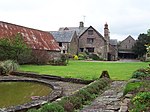
|
| Great Pool Hall | Llanvetherine | 5 June 1952 | SO3713618970 51°51′57″N 2°54′52″W / 51.86578°N 2.91437°W |
House | Timber-framed mansion approximately 2 km (1.2 mi) northeast of Llanvetherine, at the end of a short farm track[44] | 1924 | 
|
| Llanarth Court | Llanarth | 5 June 1952 | SO3806110470 51°47′22″N 2°53′58″W / 51.789466234942°N 2.8994188030168°W |
House | In a landscaped park southeast of Llanarth, entered by driveway under the lodge at Pit 1 km (0.62 mi) south-southwest of Llanarth[45] | 1925 | 
|
| Wern-ddu Farmhouse | Llantilio Pertholey | 5 June 1952 | SO3207715270 51°49′55″N 2°59′14″W / 51.831920493182°N 2.9871059647435°W |
Farmhouse | Off the south side of Skenfrith road about 500m east of Maindiff Court Hospital[46] | 1927 | 
|
| Court Farmhouse | Llanover | 5 June 1952 | SO3543713100 51°48′46″N 2°56′17″W / 51.812812046985°N 2.9379476438151°W |
Farmhouse | About 1 km (0.62 mi) north of Llanover village off the south side of the minor road to the parish church[47] | 1928 | 
|
| Trewyn House | Llanvihangel Crucorney | 1 September 1956 | SO3287222846 51°54′00″N 2°58′37″W / 51.90012°N 2.97705°W |
House | Manor house dating from 1692, about 2 km (1.2 mi) north of the village of Llanvihangel Crucorney, and set within a small landscaped park[48] | 1931 | 
|
| Trewyn House Dovecote | Llanvihangel Crucorney | 1 September 1956 | SO3290622919 51°54′03″N 2°58′36″W / 51.900782208216°N 2.9765658893335°W |
Dovecote | About 50m north of Trewyn House[49] | 1932 | 
|
| Little Llwygy Farmhouse | Cwmyoy | 1 September 1956 | SO3172322091 51°53′35″N 2°59′37″W / 51.89319°N 2.99359°W |
Farmhouse | Dating from the early 16th century, at the south end of Lower Cwmyoy overlooking the Vale of Ewyas[50] | 1936 | 
|
| Llanvihangel Court Garden House | Llanvihangel Crucorney | 1 September 1956 | SO3288820384 51°52′41″N 2°58′35″W / 51.877991539428°N 2.9763333739119°W |
Garden strucuture | About 100m southeast of Llanvihangel Court[51] | 1945 | 
|
| Lower Duffryn House | Grosmont | 1 September 1956 | SO4351822730 51°54′01″N 2°49′20″W / 51.900262464362°N 2.82231725887°W |
House | Approximately 3 km (1.9 mi) southwest of Grosmont village, at the end of a long farm track that runs north off the minor road to Norton[52] | 1950 | 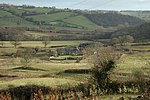
|
| Glyndŵr House | Grosmont | 1 September 1956 | SO4041024416 51°54′54″N 2°52′04″W / 51.915094813107°N 2.8677754216991°W |
House | In the centre of Grosmont village, some 50m northwest of Grosmont Town Hall on the west side of the road[53] | 1952 | 
|
| Town Farm | Grosmont | 1 September 1956 | SO4042824338 51°54′52″N 2°52′03″W / 51.914395540103°N 2.8675002392862°W |
Farmhouse | Some 50m northwest of the Church of St Nicholas in the centre of Grosmont village, on south side of the minor road leading to Great Tresenny[54] | 1953 | 
|
| Lower Tresenny Barn | Grosmont | 1 September 1956 | SO4085424071 51°54′43″N 2°51′41″W / 51.912040769107°N 2.8612616566307°W |
Barn | 400m southeast of Grosmont village, immediately south of the road junction to Middle Tresenny, and some 30m southwest of Lower Tresenny farmhouse[55] | 1954 | 
|
| Church of St James | Llangua | 1 September 1956 | SO3896725743 51°55′37″N 2°53′20″W / 51.92687°N 2.88899°W |
Church | Late 15th century church with a timber belfry, at the end of a short track leading off the A465, approximately 1 km (0.62 mi) southwest of Llangua Bridge[56] | 1958 | 
|
| Lower Celliau | Llangattock Lingoed | 1 September 1956 | SO3720921018 51°53′03″N 2°54′49″W / 51.88419°N 2.91369°W |
House | Early 16th century cruck framed hall house at the end of a farm track approximately 1 km (0.62 mi) northeast from the centre of Llangattock Lingoed[57] | 1960 | 
|
| Church of Saint Peter | Bryngwyn | 1 September 1956 | SO3905409322 51°46′45″N 2°53′05″W / 51.77925508479°N 2.8848218471944°W |
Church | In Bryngwyn village, on the west side of the lane some 500m north of the junction with old A40[58] | 1964 | 
|
| Chapel Farmhouse | Llanarth | 1 September 1956 | SO3686009399 51°46′47″N 2°55′00″W / 51.779703539759°N 2.9166336746531°W |
Farmhouse | To the north of Clytha Park, reached via a drive from Huntsman's Cottage, Pitt, or from drive past the mansion[59] | 1965 | 
|
| Clytha Park, gateway and railings | Llanarth | 1 September 1956 | SO3633308852 51°46′29″N 2°55′27″W / 51.774726253576°N 2.9241710772689°W |
Walls, railings, gates | At the main entry to Clytha Park on old A40 opposite junction with road to Bettws Newydd[60] | 1967 | 
|
| Church of Saint Teilo | Llanarth | 1 September 1956 | SO3756410961 51°47′38″N 2°54′24″W / 51.793824895949°N 2.9067120353486°W |
Church | At the south end of Llanarth village on the east side of the road in a large churchyard[61] | 1969 | 
|
| Church of St Mary and St Michael | Llanarth | 1 September 1956 | SO3806010520 51°47′24″N 2°53′58″W / 51.78991°N 2.89944°W |
Church | Immediately to the north of Llanarth Court, between the mansion and the former stable block[62] | 1971 | 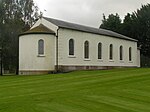
|
| Little Pitt Cottage | Llanarth | 1 September 1956 | SO3689109916 51°47′04″N 2°54′59″W / 51.784354805232°N 2.9162785644656°W |
House | On the north side of road from Llanarth to old A40 about 300m west of Pitt village[63] | 1974 | 
|
| Church of Saint Mapley | Llanvapley | 1 September 1956 | SO3667914088 51°49′19″N 2°55′12″W / 51.821836354728°N 2.9201149018994°W |
Church | At the east side of Llanvapley village, on north side of road[64] | 1976 | 
|
| Llanwenarth House | Llanfoist | 1 September 1956 | SO2587713973 51°49′10″N 3°04′36″W / 51.819471376304°N 3.0767856272697°W |
Commercial | Small country house set in its own grounds to the south of the Monmouthshire and Brecon Canal and reached by a private drive from the B4246[65] | 1977 | 
|
| Church of St Peter | Llanwenarth | 1 September 1956 | SO2756514812 51°49′38″N 3°03′09″W / 51.82724°N 3.05248°W |
Church | On the flood plain of the River Usk and reached from the by-road south of the A40[66] | 1980 | 
|
| Church of St Cadoc | Llangattock-juxta-Usk | 1 September 1956 | SO3303209647 51°46′53″N 2°58′20″W / 51.781487060037°N 2.9721608218467°W |
Church | By the River Usk and the railway line to the south-west of The Bryn[67] | 1988 | 
|
| Llangattock Court | Penpergwm | 1 September 1956 | SO3328110262 51°47′13″N 2°58′07″W / 51.787045548392°N 2.9686703726559°W |
House | On the north side of the B4598 about 200m west of the former King of Prussia public house[68] | 1990 | 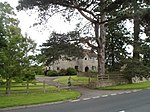
|
| Church of St Bartholomew | Llanover | 1 September 1956 | SO3179509426 51°46′46″N 2°59′24″W / 51.779350627234°N 2.9900457406724°W |
Church | About 1200m north of Llanover village by the River Usk and on the west side of the minor road from Llanellen to Llanfair Kilgeddin[69] | 1992 | 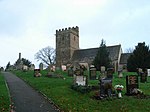
|
| Church of St Michael | Llanvihangel Gobion | 1 September 1956 | SO3460809228 51°46′40″N 2°56′57″W / 51.77791°N 2.94924°W |
Church | About 250m to the southwest of the village centre down a dead end road off the B4598[70] | 1998 | 
|
| Blaengavenny Farmhouse | Llanvihangel Crucorney | 1 September 1956 | SO3111319653 51°52′16″N 3°00′07″W / 51.871203330019°N 3.0019681212727°W |
Farmhouse | On the old Abergavenny-Hereford road halfway between Llanvihangel Crucorney and Pantygelli[71] | 2003 | 
|
| Moynes Court | Mathern | 10 June 1953 | ST5198190937 51°36′55″N 2°41′42″W / 51.615226569949°N 2.6949241046111°W |
House | About 300m west of the Church of St Tewdric approached up a lane off the road through Mathern immediately to the south of the M48[72] | 2008 | 
|
| St Pierre Hotel Gatehouse | Mathern | 10 June 1953 | ST5150690573 51°36′43″N 2°42′06″W / 51.611913164832°N 2.7017333378221°W |
Gatehouse | Forming the main entrance to the St Pierre Hotel[73] | 2010 | 
|
| Piercefield House | St Arvans | 4 August 1970 | ST5281095680 51°39′29″N 2°41′01″W / 51.657939286602°N 2.6835931007269°W |
House | About 1000m to the north east of the Lion Gates at the roundabout where the A466 crosses the B4293, the central block and the West and East pavilions have separate listings[74] Additional reference numbers:[75][76] |
2013 | 
|
| Church of St Stephen and St Tathan | Caerwent | 19 August 1955 | ST4687190485 51°36′39″N 2°46′07″W / 51.610702631716°N 2.7686506974347°W |
Church | In the centre of Caerwent village[77] | 2014 | 
|
| Church of St Michael | Llanfihangel Tor-y-Mynydd | 19 August 1955 | SO4639501856 51°42′46″N 2°46′38″W / 51.71289°N 2.77727°W |
Church | In the village of Llanfihangel Tor-y-Mynydd. Dating from the late 15th century, with a two-light bellcote[78] | 2020 | 
|
| Church of St Thomas à Becket | Wolvesnewton | 19 August 1955 | ST4542099770 51°41′39″N 2°47′28″W / 51.69404°N 2.79106°W |
Church | In the centre of Wolvesnewton village on the north side of the road west from Cobbler's Plain[79] | 2023 | 
|
| Church of St Thomas a Becket, churchyard cross | Wolvesnewton | 19 August 1955 | ST4542799752 51°41′38″N 2°47′27″W / 51.693877866688°N 2.7909510484154°W |
Cross | About 15m south of the church[80] | 2024 | 
|
| Church of the Holy Cross | Kilgwrrwg | 19 August 1955 | ST4621798451 51°40′56″N 2°46′46″W / 51.68226°N 2.77932°W |
Church | About 500m north of Kilgwrrwg House and approached by a footpath from it[81] | 2025 | 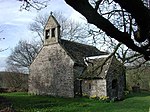
|
| Allt-y-Bela | Llangwm | 19 August 1955 | SO4110400576 51°42′03″N 2°51′13″W / 51.700847818936°N 2.8536272088685°W |
House | Accessible only from Llangeview, at east end of lane, about 1 km (0.62 mi) from junction some 500m east of Llangeview church[82] | 2031 | 
|
| Cwrt y Brychan barn, stable and granary | Llangwm | 19 August 1955 | SO4494401526 51°42′35″N 2°47′54″W / 51.709779326385°N 2.7982189219026°W |
Farm buildings | Just east of Cwrt y Brychan across yard[83] | 2033 | 
|
| Church of St Michael and All Angels | Llanfihangel Rogiet | 19 August 1955 | ST4511987861 51°35′13″N 2°47′37″W / 51.58694°N 2.79354°W |
Church | Between Green Farm and Old Court Farm south of Caldicot Road[84] | 2035 | 
|
| Manor Farmhouse | Crick | 19 August 1955 | ST4902990257 51°36′32″N 2°44′15″W / 51.60885°N 2.73746°W |
Farmhouse | On the north side of the A48 at the east end of Crick by the M4 bridge[85] | 2038 | 
|
| Moynes Court Gatehouse | Mathern | 19 August 1955 | ST5201090964 51°36′56″N 2°41′40″W / 51.61547°N 2.69451°W |
House | The surviving part of a castle probably from the 14th-century, standing about 250m west of the Church of St Tewdric[86] | 2042 | 
|
| Church of St Mary | Rogiet | 19 August 1955 | ST4566387647 51°35′06″N 2°47′08″W / 51.58507°N 2.78565°W |
Church | On the western edge of the modern village[87] | 2047 | 
|
| Howick Farmhouse | Itton | 19 August 1955 | ST5022795567 51°39′24″N 2°43′15″W / 51.65670°N 2.72091°W |
Farmhouse | Mid-16th century house rich in 17th century interior features, about 500m northeast of Itton Road, the B4293[88] | 2049 | 
|
| St Anne's House | Tintern | 19 August 1955 | ST5318799956 51°41′47″N 2°40′43″W / 51.696414482174°N 2.6787181811921°W |
House | At the junction of the A466 and Chapel Lane and about 200m east of Tintern Abbey[89] | 2051 | 
|
| Church Farmhouse | Caldicot | 5 July 1973 | ST4823788820 51°35′45″N 2°44′55″W / 51.595860967065°N 2.7486794629968°W |
Farmhouse | About 200m north of the Church of St Mary approached off Church Road via Taff Road[90] | 2055 | 
|
| Great Killough | Llantilio Crossenny | 5 January 1952 | SO3823213986 51°49′16″N 2°53′51″W / 51.821093595094°N 2.8975676695316°W |
House | Approximately 2 km (1.2 mi) southwest of Llantilio Crossenny church, at the end of a short drive which runs south off the B4521[91] | 2056 | 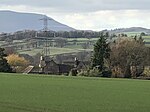
|
| The Pant | Llanvihangel-Ystern-Llewern | 5 January 1952 | SO4234614045 51°49′19″N 2°50′16″W / 51.82206°N 2.83790°W |
House | A mid-16th century cruck framed hall-house at the end of a short farm track off the minor road between Onen and Wernrheolydd[92] | 2057 | 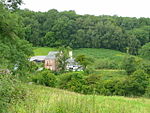
|
| Trivor Farmhouse | St Maughans | 5 January 1952 | SO4649117731 51°51′20″N 2°46′42″W / 51.85562°N 2.77834°W |
Farmhouse | A farmhouse with an unusual plan, dating from circa 1630, in an isolated position on a spur of high ground on the west side of the Monnow valley, north-northeast of St Maughan's church[93] | 2058 | 
|
| Hilston Park | Llangattock Vibon Avel | 5 January 1952 | SO4466418748 51°51′52″N 2°48′18″W / 51.864579640235°N 2.8050232526416°W |
House | Approximately 2 km (1.2 mi) southwest of Skenfrith village, standing in its own parkland on the southeast side of the B4347[94] | 2059 | 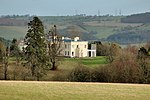
|
| Troy House | Mitchel Troy | 5 January 1952 | SO5093511352 51°47′55″N 2°42′46″W / 51.798675965048°N 2.7129102008103°W |
House | On the south bank of the River Trothy, off the south side of a bend in the road about 1.5 km (0.93 mi) south of Monmouth[95] | 2060 | 
|
| Dingestow Court | Dingestow | 5 January 1952 | SO4506409715 51°47′00″N 2°47′52″W / 51.783411876656°N 2.797778617519°W |
House | Standing in its own grounds, about 1 km (0.62 mi) southwest of the church of St Dingat[96] | 2061 | 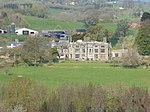
|
| Llwyn-y-gaer House | Tregare | 5 January 1952 | SO4046111111 51°47′44″N 2°51′53″W / 51.795489963096°N 2.8647374512734°W |
House | About 1.6 km (0.99 mi) northwest of the church of St Mary, off the west side of a minor road between Tregare and Llantilio Crossenny[97] | 2062 | 
|
| The Artha | Tregare | 5 January 1952 | SO4232009654 51°46′57″N 2°50′15″W / 51.782586711956°N 2.837541949815°W |
Farmhouse | About 800m southeast of the church of St Mary, at the bottom of a long track running southeast from a bend in an old lane to the south of the minor road between Tregare and Dingestow[98] | 2063 | 
|
| Old Trecastle Farmhouse | Pen-y-clawdd | 5 January 1952 | SO4516806991 51°45′32″N 2°47′45″W / 51.758932889844°N 2.7958401704515°W |
Farmhouse | Approached by a drive of some 300m, running west from road some 800m south of church at Penyclawdd[99] | 2066 | 
|
| Treworgan Manor | Llansoy | 5 January 1952 | SO4210005081 51°44′29″N 2°50′24″W / 51.741452300833°N 2.8399672003299°W |
House | Situated some 3 km (1.9 mi) south-southeast of Raglan on the west side of the road to Llansoy, on a rise overlooking Treworgan Common[100] | 2067 | 
|
| Hygga House Dovecote | Trellech | 5 January 1952 | SO4855803647 51°43′45″N 2°44′46″W / 51.72919171226°N 2.7462331282178°W |
Dovecote | About 500m north east of the Church of St Dennis at Llanishen and approached down a lane on the east side of Chepstow Road, the B4293[101] | 2071 | 
|
| Church of St Michael and All Angels | Llanvihangel-Ystern-Llewern | 19 November 1953 | SO4328113955 51°49′17″N 2°49′28″W / 51.82135°N 2.82432°W |
Church | Medieval church with a 15th-century wagon roof, located in the centre of Llanvihangel-ystern-llewern[102] | 2072 | 
|
| Brynderi House | Llantilio Crossenny | 19 November 1953 | SO3938417245 51°51′02″N 2°52′53″W / 51.850518012759°N 2.8814281189328°W |
House | Approximately 2 km (1.2 mi) north of Llantilio Crossenny, set in landscaped grounds approached along a short entrance drive that runs south off the minor road from White Castle to Cross Ash[103] | 2074 | 
|
| Croft Farm Barn | Llantilio Crossenny | 19 November 1953 | SO3797317833 51°51′20″N 2°54′07″W / 51.855648667364°N 2.9020159066027°W |
Barn | Approximately 1 km (0.62 mi) north of White Castle, on the west side of the minor road which runs between White Castle and the B4521[104] | 2077 | 
|
| Upper Green | Llantilio Crossenny | 19 November 1953 | SO3874819020 51°51′59″N 2°53′28″W / 51.866405351102°N 2.8909755550137°W |
House | Approximately 4 km (2.5 mi) north of Llantilio Crossenny, at the end of a short farm track approached by the minor road which runs N off the B4521 towards Llanfair Green[105] | 2078 | 
|
| Skenfrith Castle | Skenfrith | 19 November 1953 | SO4570020262 51°52′42″N 2°47′25″W / 51.878292567865°N 2.7902181881841°W |
Castle | At the southeast corner of Skenfrith village, close to the west bank of the Monnow and approximately 100m northwest of Skenfrith Bridge[106] | 2083 | 
|
| Church of St Maughan | Llangattock Vibon Avel | 19 November 1953 | SO4611217162 51°51′02″N 2°47′02″W / 51.85046°N 2.78375°W |
Church | In farmland approximately 7 km (4.3 mi) northwest of Monmouth, in an almost isolated position down a narrow lane off the northeast side of the B4347[107] | 2084 | 
|
| Church of St Michael and All Angels | Mitchel Troy | 19 November 1953 | SO4921710399 51°47′24″N 2°44′16″W / 51.78995°N 2.73768°W |
Church | In the centre of Mitchel Troy village, on the north side of the old road from Monmouth to Raglan[108] | 2086 | 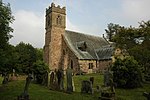
|
| Pwll | Tregare | 19 November 1953 | SO4098109698 51°46′58″N 2°51′25″W / 51.782842330054°N 2.8569573960975°W |
House | 2 km north of Raglan, and about 950m southwest of St Mary's Church, Tregare, at the bottom of an L-shaped track off the west side of a minor road[109] | 2090 | 
|
| Ty Mawr | Dingestow | 19 November 1953 | SO4376709959 51°47′08″N 2°49′00″W / 51.785476318133°N 2.8166179585316°W |
Farmhouse | On the north side of the minor road between Dingestow and Tregare, about 2 km (1.2 mi) west of Dingestow church[110] | 2092 | 
|
| Ty Mawr Gatehouse | Dingestow | 19 November 1953 | SO4378409929 51°47′07″N 2°48′59″W / 51.785208327446°N 2.8163666662743°W |
Gatehouse | On the north side of the minor road between Dingestow and Tregare, about 2 km (1.2 mi) west of Dingestow church[111] | 2093 | 
|
| Pen-y-clawdd Farmhouse | Raglan | 19 November 1953 | SO4395708308 51°46′14″N 2°48′49″W / 51.770652744157°N 2.8135967462009°W |
Farmhouse | At the end of an access road to the south side service station on A40, on west side of Raglan to Penyclawdd lane[112] | 2099 | 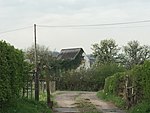
|
| Church of St Cadoc | Raglan | 19 November 1953 | SO4134007684 51°45′53″N 2°51′05″W / 51.764774232045°N 2.8514129898452°W |
Church | At the principal crossroads in Raglan, in a churchyard contained within a stone wall which is entered by a 19th-century lychgate[113] | 2100 | 
|
| Pant-glas Farmhouse | Llanishen | 19 November 1953 | SO4813704110 51°44′00″N 2°45′09″W / 51.733315346938°N 2.7523973506734°W |
Farmhouse | About 1200m to the north east of the Church of St Dennis at Llanishen approached down a lane off the west side of the Chepstow Road, the B4293[114] | 2103 | 
|
| Usk Bridge | Usk | 4 January 1974 | SO3742900734 51°42′07″N 2°54′25″W / 51.701869653565°N 2.9068257463166°W |
Bridge | On the west side of Usk; carries the A472 across the river[115] | 2129 | 
|
| Sessions House | Usk | 4 January 1974 | SO3783000544 51°42′01″N 2°54′04″W / 51.700206212792°N 2.9009899936509°W |
Courthouse | Towards the southern edge of the town, adjacent to the prison[116] | 2154 | 
|
| Usk Prison | Usk | 4 January 1974 | SO3787300460 51°41′58″N 2°54′01″W / 51.699455822204°N 2.9003528838404°W |
Prison | On a large site in a dominant position in the landscape of the low-lying southern area of the town[117] | 2155 | 
|
| Ynys Hafod | Usk | 16 February 1953 | SO3755100579 51°42′02″N 2°54′18″W / 51.70049°N 2.90503°W |
House | A long range (with Henllys and Min Yr Afon) of 16th-century origin in the middle of the west side of New Market Street[118] | 2169 | 
|
| Porth-y-carn | Usk | 4 January 1974 | SO3752000990 51°42′15″N 2°54′20″W / 51.704181258532°N 2.9055550855252°W |
House | Just north of town centre and set back from the road in a garden, reached by a short drive and backing onto the River Usk[119] | 2189 | 
|
| Church of St Thomas the Martyr | Monmouth | 27 June 1952 | SO5044012454 51°48′31″N 2°43′13″W / 51.808539487553°N 2.7202456180308°W |
Church | Part of a group immediately outside Monnow Bridge forming the centre of the historic suburb of Overmonnow[120] | 2214 | 
|
| Church of St Peter | Dixton | 27 June 1952 | SO5196613564 51°49′07″N 2°41′54″W / 51.81865°N 2.69827°W |
Church | About 1500m northeast of Monmouth approached from the roundabout at the north entrance to the town[121] | 2215 | 
|
| Clawdd-du Bridge | Monmouth | 15 August 1974 | SO5024912339 51°48′27″N 2°43′23″W / 51.807488599388°N 2.7229991697438°W |
Bridge | On a footpath going south-west from St Thomas' Square where it crosses the ditch which protected the suburb of Overmonnow[122] | 2219 | 
|
| Roundhouse at The Kymin | Monmouth | 27 June 1952 | SO5276512498 51°48′33″N 2°41′12″W / 51.80913686387°N 2.6865316162974°W |
Folly | On the top of the hill overlooking the town on the east side, approached from the Staunton Road[123] | 2222 | 
|
| Agincourt House | Monmouth | 27 June 1952 | SO5079912882 51°48′45″N 2°42′54″W / 51.81242°N 2.71510°W |
Commercial | In the town square in the centre of Monmouth[124] | 2223 | 
|
| Beaufort Arms Hotel | Monmouth | 27 June 1952 | SO5080812840 51°48′43″N 2°42′54″W / 51.81204°N 2.71496°W |
Commercial | Now apartments, in the town square behind the Shire Hall in the centre of Monmouth[125] | 2227 | 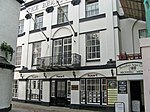
|
| Statue of Charles Rolls | Monmouth | 15 August 1974 | SO5077012846 51°48′44″N 2°42′56″W / 51.81209°N 2.71552°W |
Statue | In the cobbled area in front of the Shire Hall within the town square at the centre of Monmouth[126] | 2229 | 
|
| Kings Head Hotel | Monmouth | 27 June 1952 | SO5075912810 51°48′42″N 2°42′56″W / 51.811768285239°N 2.7156698194677°W |
Commercial | In the town square in the centre of Monmouth[127] The former County Club at 9 Agincourt Square by Thomas Henry Wyatt now forms part of the hotel. Additional reference numbers:[128] |
2230 | 
|
| 9 Agincourt Street | Monmouth | 27 June 1952 | SO5080412793 51°48′42″N 2°42′54″W / 51.811619423031°N 2.7150147110208°W |
Commercial | In the street leading southeast out of the town square in the centre of Monmouth[129] | 2242 | 
|
| 12 Church Street | Monmouth | 27 October 1965 | SO5082312922 51°48′46″N 2°42′53″W / 51.812780844164°N 2.7147574853217°W |
Commercial | In the street leading northeast out of the town square in the centre of Monmouth[130] | 2253 | 
|
| Glendower House | Monmouth | 27 October 1965 | SO5086012761 51°48′41″N 2°42′51″W / 51.811336672633°N 2.7141979293002°W |
House | An 1840s classical chapel which has retained its character despite conversion to domestic use[131] | 2272 | 
|
| Royal George House | Monmouth | 27 June 1952 | SO5097713049 51°48′50″N 2°42′45″W / 51.813936171225°N 2.7125418009923°W |
Commercial | On the principal road which runs north-south on the east side of Monmouth town centre[132] | 2282 | 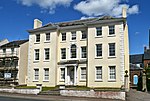
|
| Lord Nelson's Seat | Monmouth | 27 June 1952 | SO5077912728 51°48′40″N 2°42′55″W / 51.811032848958°N 2.7153680592672°W |
Garden structure | In the garden behind No. 18, but accessed from the Chippenham[133] | 2290 | 
|
| Cornwall House, railings & gates | Monmouth | 15 August 1974 | SO5062712695 51°48′39″N 2°43′03″W / 51.810722731212°N 2.7175679473344°W |
Walls, railings, gates | At the front of the building, on Monmouth's principal commercial street which leads out of the town square going southwest to Monnow Bridge[134] | 2293 | 
|
| Robin Hood Inn | Monmouth | 27 June 1952 | SO5051212562 51°48′34″N 2°43′09″W / 51.80952°N 2.71922°W |
Commercial | On Monmouth's principal commercial street which leads out of the town square going southwest to Monnow Bridge[135] | 2297 | 
|
| Chapel House | Monmouth | 27 June 1952 | SO5091713213 51°48′55″N 2°42′48″W / 51.81541°N 2.71344°W |
House | On the principal road leading north from Monmouth centre set between Monk Street and Hereford Road[136] | 2309 | 
|
| Old Nag's Head | Monmouth | 26 April 1955 | SO5112712967 51°48′48″N 2°42′37″W / 51.813212138203°N 2.710354469363°W |
Commercial | On the historic north and east entry to the town, but now a cul-de-sac[137] | 2312 | 
|
| The Shambles | Monmouth | 15 August 1974 | SO5081612998 51°48′48″N 2°42′54″W / 51.813463487179°N 2.7148698318419°W |
Museum | Part of the group on the principal street leading north and east from the town square[138] | 2318 | 
|
| White Swan Inn | Monmouth | 27 June 1952 | SO5080812931 51°48′46″N 2°42′54″W / 51.812860433322°N 2.7149763340807°W |
Commercial | Part of the group on the principal street leading north and east from the town square and accessed between Nos. 4 & 5[139] | 2321 | 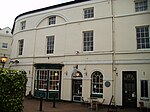
|
| Monmouth Priory | Monmouth | 27 June 1952 | SO5086813008 51°48′49″N 2°42′51″W / 51.813557974867°N 2.714117006597°W |
Community Centre | Part of the group on the principal street leading north and east from the town square[140] | 2323 | 
|
| Monmouth Methodist Church | Monmouth | 27 June 1952 | SO5102312905 51°48′46″N 2°42′43″W / 51.812645614598°N 2.7118541699233°W |
Church | Set back from the street line, within the linear group of historic buildings leading to St James's Square on the east side of Monmouth and about 300m east of the town centre[141] | 2342 | 
|
| The Tithe Barn | Abergavenny | 5 July 1952 | SO3005114110 51°49′16″N 3°00′59″W / 51.821242086511°N 3.0162675239829°W |
Barn | Part of the group of historic buildings near the parish church of St Mary's in a street branching off the main commercial centre of Abergavenny[142] | 2375 | 
|
| Abergavenny Bridge | Abergavenny/Llanfoist | 5 July 1952 | SO2915113947 51°49′11″N 3°01′45″W / 51.81966°N 3.02929°W |
Bridge | 15th-century, much-altered bridge spanning the River Usk and the boundary between Abergavenny and Llanfoist[143] Additonal reference numbers:[144] |
2378 | 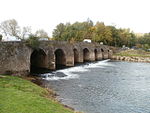
|
| Church of Our Lady and St Michael RC | Abergavenny | 11 January 1974 | SO2968214648 51°49′34″N 3°01′18″W / 51.82603204227°N 3.0217297046463°W |
Church | On the west side of Pen-y-pound and one of the varied group of historic buildings on the main northeastern access to Abergavenny[145] | 2467 | 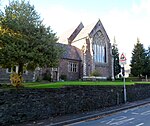
|
| St John's Masonic Lodge | Abergavenny | 5 July 1952 | SO2983914198 51°49′19″N 3°01′10″W / 51.822006532919°N 3.0193606713968°W |
Masonic Lodge | In Abergavenny town centre just to the west of the High Street[146] | 2470 | 
|
| Raglan Lodge | Chepstow | 30 April 1956 | ST5336093934 51°38′32″N 2°40′31″W / 51.642287737301°N 2.6754093418336°W |
House | At the northwest upper corner of Beaufort Square[147] | 2501 | 
|
| 14 Beaufort Square | Chepstow | 6 December 1950 | ST5336693922 51°38′32″N 2°40′31″W / 51.642180348908°N 2.675321037383°W |
House | At the very northwest corner of the square opposite the war memorial[148] | 2502 | 
|
| Castle Terrace | Chepstow | 14 March 1955 | ST5350994126 51°38′38″N 2°40′24″W / 51.644026305046°N 2.6732818399244°W |
Houses | No.s 33a-47 inclusive a continuous sloping terrace between Ashburne House at the bottom of the hill and number 48 at top[149] | 2520 | 
|
| Powis Almshouses | Chepstow | 24 March 1975 | ST5343594022 51°38′35″N 2°40′28″W / 51.643085142629°N 2.674337318585°W |
Almshouses | At the very top of Bridge Street facing junction with Upper Church Street, set above and back from the road behind a walled court and garden[150] | 2524 | 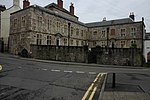
|
| Church of St Illtyd | Mamhilad | 18 November 1980 | SO3053703427 51°43′31″N 3°00′25″W / 51.72527°N 3.00708°W |
Church | In the centre of Mamhilad village[151] | 2612 | 
|
| Persondy | Mamhilad | 3 April 1952 | SO3010303230 51°43′24″N 3°00′48″W / 51.72344°N 3.01332°W |
House | About 500m southwest of the Church of St Illtyd[152] | 2619 | 
|
| Ty-Cooke Farmhouse | Mamhilad | 3 April 1952 | SO3088705242 51°44′30″N 3°00′09″W / 51.741626209588°N 3.0023716267303°W |
Farmhouse | About 2000m north of Mamhilad village, a mostly original house built circa 1710[153] | 2623 | 
|
| Church of All Saints | Kemeys Commander | 18 November 1980 | SO3490004798 51°44′17″N 2°56′39″W / 51.738116280115°N 2.9441767757009°W |
Church | In the centre of hamlet of Kemeys Commander, west of the main A471 road[154] | 2626 | 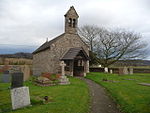
|
| Church Farmhouse | Kemeys Commander | 3 April 1952 | SO3489604721 51°44′15″N 2°56′39″W / 51.73742°N 2.94422°W |
Farmhouse | Immediately south of the churchyard at Kemeys Commander[155] | 2629 | 
|
| Church of St David | Trostrey | 18 November 1980 | SO3599304411 51°44′05″N 2°55′42″W / 51.73476°N 2.92828°W |
Church | An early 14th century church in an isolated hillside position up a lane off the A471 between Llancayo and Kemeys Commander[156] | 2630 | 
|
| Trostrey Court | Trostrey | 3 April 1952 | SO3655404397 51°44′05″N 2°55′13″W / 51.73470°N 2.92015°W |
House | Some 1.3 km (0.81 mi) up lane running north from the A471 at Llancayo, on the west side of road[157] | 2641 | 
|
| Church of St Madoc | Llanbadoc | 18 November 1980 | SO3760300073 51°41′45″N 2°54′15″W / 51.69595°N 2.90419°W |
Church | On the east side of the Caerleon road about 700m south of Usk Bridge[158] | 2651 | 
|
| Church of St Cybi | Llangybi | 18 November 1980 | ST3741096686 51°39′56″N 2°54′23″W / 51.665475839801°N 2.9063734518325°W |
Church | In the centre of Llangybi village immediately to the east of the White Hart public house[159] | 2669 | 
|
| Llanddewi Court | Llangybi | 3 April 1952 | ST3177697595 51°40′23″N 2°59′17″W / 51.672990429476°N 2.9879990963909°W |
House | Approached down a track off the north side of the road to Coed-y-paen and about 1300m north east of the roundabout on the A4042[160] | 2676 | 
|
| New House Farm | Llangybi | 18 November 1980 | ST3726496850 51°40′01″N 2°54′31″W / 51.666933893431°N 2.9085136371465°W |
Farmhouse | On the west side of the Usk-Caerleon road at the northern exit of Llangybi village[161] | 2680 | 
|
| Ton Farmhouse | Llangybi | 3 April 1952 | ST3649495831 51°39′28″N 2°55′10″W / 51.657686351852°N 2.9194601612812°W |
Farmhouse | Off the south side of Ton Road and about 1200m south west of Llangybi village[162] | 2686 | 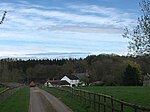
|
| White Hart Inn | Llangybi | 3 April 1952 | ST3734396691 51°39′56″N 2°54′26″W / 51.665513306933°N 2.9073429524112°W |
Commercial | At the crossroads in the centre of Llangybi village[163] | 2688 | 
|
| Church of St Andrew | Tredunnock | 18 November 1980 | ST3798394857 51°38′57″N 2°53′52″W / 51.649096610349°N 2.8977646480848°W |
Church | In the centre of Tredunnock village[164] | 2689 | 
|
| Berllan-deg | Llanhennock | 3 April 1952 | ST3570294612 51°38′48″N 2°55′50″W / 51.646637268509°N 2.9306833379004°W |
House | About 100m west of the Caerleon-Usk road and just south of the branch road to Croesyceiliog[165] | 2691 | 
|
| Glen Usk | Llanhennock | 3 April 1952 | ST3633892683 51°37′46″N 2°55′16″W / 51.629367935033°N 2.9211411709555°W |
House | On the west bank of the River Usk, sited in a natural amphitheatre within the steep, wooded valley side, about 1 km (0.62 mi) east of Llanhennock[166] | 2697 | 
|
| The Cwm | Llantrisant | 3 April 1952 | ST3954297197 51°40′13″N 2°52′32″W / 51.670303750638°N 2.8756400373399°W |
House | House originating in the 16th century, situated 350m northeast of Llantrisant, just east of A449 trunk road[167] | 2710 | 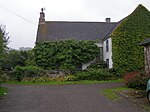
|
| Nantybanw | Llantrisant | 3 April 1952 | ST4072797251 51°40′15″N 2°51′31″W / 51.67091577341°N 2.8585159366932°W |
House | Some 2 km (1.2 mi) east of Llantrisant, in valley of Nant y Banwr[168] | 2716 | 
|
| Pentwyn | Llanllowell | 18 November 1980 | ST3917899091 51°41′14″N 2°52′52″W / 51.68729°N 2.88123°W |
House | House originating in the late 16th-century, about 0.5 km (0.31 mi) north of Llanllowell church, on west side of lane to Llangeview[169] | 2717 | 
|
| Mathern Mill | Mathern | 9 June 1974 | ST5154091637 51°37′17″N 2°42′05″W / 51.621482096843°N 2.7013898599451°W |
Mill | About 1000m north of the Church of St Tewdric on the lane to Caerwent[170] | 2732 | 
|
| Great Tresenny Farmhouse | Grosmont | 11 October 1983 | SO4035624098 51°54′44″N 2°52′07″W / 51.91223°N 2.86851°W |
Farmhouse | 17th-century three unit farmhouse, about 300m south of Grosmont village on the east side of the road[171] | 2763 | 
|
| Manor Farmhouse and Manor Cottage | Portskewett | 7 April 1984 | ST4977388242 51°35′27″N 2°43′35″W / 51.590803807631°N 2.7264239503835°W |
Farmhouse | In Crick Road at the junction with Main Road[172] | 2768 | 
|
| The Hendre | Llangattock Vibon Avel | 4 November 1985 | SO4586814128 51°49′23″N 2°47′13″W / 51.823163896673°N 2.7868153548792°W |
House | Monmouthshire's only full-scale Victorian country-house in its own grounds to the south of the B4233, 5 km west of Monmouth[173] | 2773 | 
|
| St Mary's Priory Church, churchyard walls, railings, gate piers and gates | Monmouth | 15 August 1974 | SO5091412955 51°48′47″N 2°42′48″W / 51.813085542372°N 2.7134422597664°W |
Walls, railings, gates | On the street continuing the line of Church Street east out of the town centre[174] | 2780 | 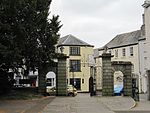
|
| St Mary's Priory Church, Monmouth | Monmouth | 27 June 1952 | SO5088112969 51°48′48″N 2°42′50″W / 51.813208499789°N 2.7139229020039°W |
Church | On the street continuing Church Street east out of the town centre[175] | 2784 | 
|
| Great House | Llanover | 1 September 1956 | SO3356611334 51°47′48″N 2°57′53″W / 51.796716521019°N 2.9647448674252°W |
House | Reached along by-roads from the Abergavenny to Raglan road at junction opposite the former King of Prussia inn[176] | 2785 | 
|
| Tal-y-coed Court | Llantilio Crossenny | 1 June 1988 | SO4212715210 51°49′57″N 2°50′29″W / 51.83251523121°N 2.8412690337509°W |
House | Approximately 2 km (1.2 mi) east of Llantilio Crossenny village, on a terraced site above a tributary of the River Trothy, approached through parkland along a driveway which runs north off the B4233[177] | 2787 | 
|
| Savoy Theatre | Monmouth | 2 September 1989 | SO5083912938 51°48′47″N 2°42′52″W / 51.81292609954°N 2.7145276886229°W |
Theatre | In the street leading northeast out of the town square in the centre of Monmouth[178] | 2812 | 
|
| High Glanau | Mitchel Troy | 22 February 1989 | SO4981707403 51°45′47″N 2°43′43″W / 51.763073846241°N 2.7285489001314°W |
House | Off the west side of the road, approached along a wooded drive on Trellech Hill, and set in its own grounds, on a levelled site with sloping lawns to either side and views to west[179] | 2813 | 
|
| High Glanau terraces | Mitchel Troy | 22 February 1989 | SO4980607400 51°45′47″N 2°43′43″W / 51.763045886871°N 2.7287078397626°W |
Garden structure | Off the west side of the road, approached along a wooded drive on Trellech Hill, immediately on the west side of the house[180] | 2814 | 
|
| Bridges Community Centre, formerly Drybridge House | Monmouth | 3 June 1991 | SO5024412567 51°48′34″N 2°43′23″W / 51.80953793268°N 2.7231044959404°W |
Community Centre | Situated on the west bank of the River Monnow, in its own grounds at the junction of the roads to Rockfield and Dingestow[181] | 2852 | 
|
| Upper Red House | Llanvihangel-Ystern-Llewern | 4 September 1991 | SO4278913050 51°48′47″N 2°49′53″W / 51.81316°N 2.83131°W |
House | On sloping ground reached via a branch in the minor road which runs approximately 1 km (0.62 mi) southwest from Llanvihangel-ystern-llewern church[182] | 2855 | 
|
| Swiss Cottage | Rockfield | 9 March 1991 | SO4808714365 51°49′32″N 2°45′17″W / 51.82551°N 2.75466°W |
Gatehouse | A former lodge dating from 1905 by Sir Aston Webb, reached from B4233 at the south end of Rockfield; approximately 0.5 km (0.31 mi) along a tree-lined drive[183] | 2857 | 
|
| Milbrook | Llanvihangel Crucorney | 24 September 1991 | SO3244820836 51°52′55″N 2°58′58″W / 51.882001576609°N 2.9828127783369°W |
House | On the north west edge of the village, on the corner at the road junction beside Pen-y-bont bridge over the Afon Honddu[184] | 2858 | 
|
| Newhouse Farm | Llanvetherine | 27 February 1992 | SO3662716422 51°50′34″N 2°55′17″W / 51.84281°N 2.92130°W |
Farmhouse | Approximately 1 km (0.62 mi) south of Llanvetherine, on southwest side of a minor road[185] | 2862 | 
|
| Coed-y-gelli | Llanarth | 25 March 1992 | SO3705411476 51°47′54″N 2°54′51″W / 51.79839738422°N 2.9141995269984°W |
House | At end of Heol y Ffynnon, lane of some 750m running northwest from Yr Hen Ysgoldy opposite church in Llanarth[186] | 2866 | 
|
| Tregeiriog House | Llanishen | 26 March 1993 | SO4553004093 51°43′58″N 2°47′25″W / 51.732914649966°N 2.790141044394°W |
Farmhouse | On a sloping site beside the by-road, approximately 2 km (1.2 mi) north west of Llanishen and 1.5 km (0.93 mi) south of Llangoven, the house is set back behind a front garden with the former farmyard uphill to the west[187] | 2885 | 
|
| Troy House walled garden | Mitchel Troy | 29 March 1993 | SO5080811354 51°47′55″N 2°42′53″W / 51.798682760307°N 2.7147519852421°W |
Garden structure | On sloping ground about 50m west of Troy House on the south bank of the River Trothy, on the west side of a farm track running south from a bend in the road about 1.5 km (0.93 mi) south of Monmouth[188] | 2886 | 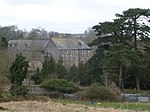
|
| The Argoed | Penallt | 15 July 1993 | SO5230108442 51°46′21″N 2°41′34″W / 51.772632518482°N 2.692702141707°W |
House | Set in its own landscaped grounds about 600m south of Penallt (Pentwyn) with views to the east, reached from the west drive, close to the fork in the by-road to Tregagle[189] | 2892 | 
|
| Court Farmhouse | Llanthony | 18 August 1993 | SO2882327859 51°56′41″N 3°02′13″W / 51.94468°N 3.03692°W |
Farmhouse | Immediately to south-west of Llanthony Priory adjoining the Abbey Hotel, the building of which formed the west cloister range[190] | 2895 | 
|
| Grove Farm House | Llanfoist | 15 September 1993 | SO2925412772 51°48′33″N 3°01′39″W / 51.809113570199°N 3.0275551429133°W |
Farmhouse | Set in its own grounds south of Llanfoist and reached east off the B4269[191] | 2898 | 
|
| Church of St Elli | Llanelly | 19 July 1963 | SO2322214848 51°49′37″N 3°06′56″W / 51.826977794018°N 3.1154909499195°W |
Church | Prominent location on sloping ground, with its spire visible from afar, the church is set in a large churchyard, surrounded on all sides by minor roads, and with two further large churchyards to the south[192] | 6665 | 
|
| Clydach House | Llanelly | 19 July 1963 | SO2333113892 51°49′06″N 3°06′49″W / 51.818399065738°N 3.1136976406205°W |
House | On a sharp bend of the by-road between Maesygwartha and the A465, opposite the garage at Saleyard, approximately 1.5 km (0.93 mi) southwest of Maesygwartha[193] | 6667 | 
|
| Burton's | Abergavenny | 13 October 1994 | SO2984314260 51°49′20″N 3°01′05″W / 51.8221°N 3.0180°W |
Commercial | Situated on Market Street, a 1937 shop front which retains its original detailing[194] | 14875 | 
|
| Llanwenarth Baptist Chapel | Govilon | 21 October 1994 | SO2667413748 51°49′03″N 3°03′55″W / 51.817554116292°N 3.0651772059425°W |
Chapel | Situated near the centre of Govilon in a large burial ground immediately north of the Monmouthshire and Brecon Canal[195] | 14933 | 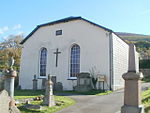
|
| Ty-Hwnt-y-Bwlch Farmhouse | Cwmyoy | 20 December 1994 | SO3028023951 51°54′35″N 3°00′54″W / 51.90974°N 3.01494°W |
Farmhouse | Late 16th-century farmhouse sited on steeply sloping ground uphill from Cwmyoy on the eastern slopes of the Vale of Ewyas; reached via a track from Penywern Farm, it retains a stone forecourt wall and boundary wall to north including set of beeboles[196] | 15659 | 
|
| The Old Cottage | Treadam, Llantilio Crossenny | 28 June 1955 | SO3801615546 51°50′06″N 2°54′04″W / 51.835093766633°N 2.9009809461602°W |
House | At right angles to the road in the hamlet of Treadam, some 2 km (1.2 mi) northwest of Llantilio Crossenny[197] | 15761 | 
|
| The Procurator's House | Magor with Undy | 31 May 1995 | ST4248587015 51°34′45″N 2°49′53″W / 51.579074102672°N 2.8314131624126°W |
House | Adjacent to churchyard to northwest of St Mary's church[198] | 16064 | 
|
| Cwm Bwchel Farmhouse | Llanthony | 8 July 1995 | SO2835127406 51°56′26″N 3°02′37″W / 51.94055°N 3.04369°W |
Farmhouse | On the west side of the valley, almost opposite Llanthony Priory, a medieval timber cruck-framed house rebuilt probably in the late 1500s[199] | 16277 | 
|
| Church of St David | Llanddewi Rhydderch | 1 September 1956 | SO3498712960 51°48′41″N 2°56′40″W / 51.81150°N 2.94445°W |
Church | To the south of the centre of Llanddewi Rhydderch village[200] | 17417 | 
|
| Church of St Bride | Llansantffraed | 1 September 1956 | SO3572510001 51°47′06″N 2°56′00″W / 51.784985927891°N 2.933195069235°W |
Church | On the eastern boundary of the community about 200m north of the A40 and approached off the Raglan road up the hotel drive to the north of Aberffrwd Bridge[201] | 17419 | 
|
| Church of St Cadoc | Penrhos | 27 November 1953 | SO4159911742 51°48′05″N 2°50′54″W / 51.801282911099°N 2.8483446412925°W |
Church | In a churchyard in the centre of village of Penrhos[202] | 17421 | 
|
| Church of St Cadoc | Llangattock Vibon Avel | 27 November 1953 | SO4565815668 51°50′13″N 2°47′24″W / 51.836988200173°N 2.7901042613955°W |
Church | Approximately 1 km (0.62 mi) north of The Hendre; and, apart from the close proximity of Llangattock Manor and Llangattock Farm, in an isolated position approximately 300m west of the lane between Hendre and Newcastle[203] | 17422 | 
|
| Church of St Dingat | Dingestow | 27 November 1953 | SO4571910410 51°47′23″N 2°47′18″W / 51.789724112717°N 2.7883934436568°W |
Church | About 5 km (3.1 mi) west southwest of Monmouth, on the north side of the junction of four minor roads, and close to the east side of the earthworks marking the site of Dingestow Castle[204] | 17424 | 
|
| Church of St Govan | Llangovan | 27 November 1953 | SO4568005481 51°44′43″N 2°47′17″W / 51.745407682892°N 2.7881863958°W |
Church | In an isolated site above Church Farm, about 2.5 km (1.6 mi) south of Penyclawdd church on minor lane to Llanishen[205] | 17426 | 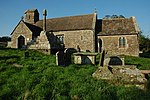
|
| Church of St Martin | Pen-y-clawdd | 27 November 1953 | SO4528107874 51°46′01″N 2°47′40″W / 51.766882299315°N 2.7943424914668°W |
Church | Prominently sited on an earthwork which forms the churchyard at the intersection of two roads at Pen-y-clawdd[206] | 17427 | 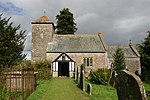
|
| Ty-mawr Farmhouse | Cwmyoy | 4 November 1996 | SO2837923237 51°54′11″N 3°02′33″W / 51.903078°N 3.042417°W |
Farmhouse | About 2.5 km (1.6 mi) north of Forest Coal Pit on the east side of the valley near Tabernacle Baptist chapel[207] | 18111 | 
|
| Church of St Catwg | Cwmcarvan | 27 November 1953 | SO4774807499 51°45′49″N 2°45′31″W / 51.763747195758°N 2.7585400101401°W |
Church | In a relatively isolated position about 2.4 km (1.5 mi) south-southwest of Monmouth, in the fork of two lanes which run south up towards Cwmcarvan Hill[208] | 18286 | 
|
| Church of St Oudoceus | Llandogo | 18 July 1997 | SO5267804078 51°44′00″N 2°41′12″W / 51.733430426568°N 2.6866432889629°W |
Church | Set in a sloping, polygonal shaped, churchyard with rubble boundary wall on the eastern edge of the village of Llandogo close to the main road, the A466[209] | 18575 | 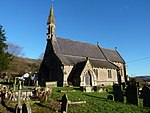
|
| Trewyn Farm barn | Llanvihangel Crucorney | 29 January 1998 | SO3267422749 51°53′57″N 2°58′48″W / 51.89922°N 2.97990°W |
Barn | On the north side of the farmyard about 30m from Trewyn Farmhouse[210] | 19246 | 
|
| Tabernacle Baptist Chapel | Cwmyoy | 29 January 1998 | SO2840522704 51°53′54″N 3°02′31″W / 51.89829°N 3.04193°W |
Chapel | About 2.5 km (1.6 mi) north of Forest Coal Pit, and just within the western boundary of the community; little altered since 1837, the adjoining Minister's House is Grade II listed[211] | 19257 | 
|
| Trewyn House, terrace walls, steps, garden walls, gatepiers and gates | Llanvihangel Crucorney | 29 January 1998 | SO3289522862 51°54′01″N 2°58′36″W / 51.90027°N 2.97671°W |
Wall, railings, gates | Below the south east front of Trewyn House forming the main approach[212] | 19260 | 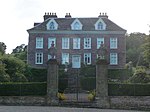
|
| Great House | Llanarth | 15 March 2000 | SO3619008095 51°46′04″N 2°55′34″W / 51.767904611761°N 2.92610402966°W |
House | Situated on the east side of the Clytha to Bettws Newydd road some 600m south of Clytha Park gates[213] | 22999 | 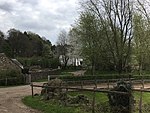
|
| Pwllyrhwyad | Llanarth | 15 March 2000 | SO3631010810 51°47′32″N 2°55′30″W / 51.792325744338°N 2.9248643687281°W |
House | Situated on the west side of road about 1 km (0.62 mi) south of Coed Morgan Farm[214] | 23012 | 
|
| Dewstow House, grottoes and garden | Caldicot | 29 March 2000 | ST4680688862 51°35′46″N 2°46′10″W / 51.596104927885°N 2.7693425621701°W |
Garden structure | In Dewstow about 1 km (0.62 mi) north of the centre of Caldicot and situated on the north east side of Dewstow Road[215] | 23059 | 
|
| New Bridge | Newbridge-on-Usk | 22 June 2000 | ST3851594814 51°38′56″N 2°53′24″W / 51.64877°N 2.89007°W |
Bridge | Triple-arched bridge built in 1779, some 2.3 km (1.4 mi) south of Llantrisant[216] Additional reference numbers:[217] |
23490 | 
|
| Ty-uchaf Farmhouse | Llanelly | 27 July 2000 | SO2264114988 51°49′41″N 3°07′26″W / 51.828155978809°N 3.1239510987255°W |
Farmhouse | Located some 0.5 km (0.31 mi) northwest of Llanelly Church, at the end of a short lane leading past Pen-y-wern, off by-road[218] | 23804 | 
|
| Smart's Bridge | Llanelly | 27 July 2000 | SO2287313270 51°48′46″N 3°07′13″W / 51.812744610134°N 3.1202020931293°W |
Bridge | Bridge is located over River Clydach forming entry to remains of Clydach Ironworks, reached off the south side of road leading to Ynys-y-garth[219] | 23813 | 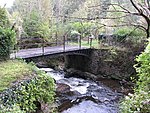
|
| Brecknock & Abergavenny Canal, embankment & aqueduct | Llanelly | 27 July 2000 | SO2439914475 51°49′26″N 3°05′54″W / 51.823785616849°N 3.0983340111369°W |
Aqueduct | To the southwest of the village in across a deep ravine of the River Clydach[220] | 23826 | 
|
| Itton Court | Itton | 10 June 1953 | ST4934395466 51°39′21″N 2°44′01″W / 51.655712770584°N 2.7336775493741°W |
House | About 250m north of the Church of St Deiniol on a once fortified hilltop site[221] | 23971 | 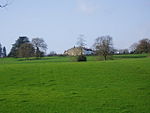
|
| Tredean House | Devauden | 9 August 2000 | ST4775899255 51°41′23″N 2°45′26″W / 51.689631966128°N 2.7571554548222°W |
House | lkm northwest of Devauden approached by a long drive off the west side of the Monmouth Road, only the gatehouse can be seen from the public highway[222] | 23978 | 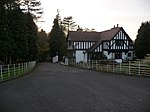
|
| Mounton House | Mounton | 10 October 2000 | ST5139093003 51°38′02″N 2°42′13″W / 51.633750255703°N 2.7037464508677°W |
Houses | About 200m southeast of Mounton village approached off the A48 at Pwllmeyric[223] | 24061 | 
|
| Wyelands | Mathern | 10 October 2000 | ST5235891923 51°37′27″N 2°41′23″W / 51.624123435016°N 2.6896140489114°W |
House | About 1100m north of the church of St Tewdric and approached off the south side of the A48 to the east of Pwllmeyric[224] | 24100 | 
|
| Howell's House | Grosmont | 19 October 2000 | SO4045524393 51°54′54″N 2°52′02″W / 51.914892871989°N 2.8671172754945°W |
House | Approximately 20m north of the town hall in the centre of Grosmont[225] | 24134 | 
|
| Upper Dyffryn House, former kitchen and dairy | Grosmont | 19 October 2000 | SO4217723425 51°54′23″N 2°50′31″W / 51.90637255828°N 2.8419218518459°W |
Dairy | On the north side of the minor road to Norton, about 2 km (1.2 mi) southwest of Grosmont village, the dairy and detached kitchen lie approximately 5m northeast of Upper Dyffryn Farmhouse[226] | 24150 | 
|
| Great House Farm | Llangua | 19 October 2000 | SO3929125910 51°55′42″N 2°53′04″W / 51.928404347673°N 2.8843061434382°W |
Farmhouse | On steeply sloping ground on east side of minor road, some 500m south of the A465 road junction to Llangua[227] | 24177 | 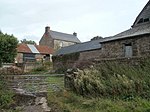
|
| Sleath Farmhouse (aka Lech Farmhouse) | Llangua | 19 October 2000 | SO3920325652 51°55′34″N 2°53′08″W / 51.92608°N 2.88554°W |
Farmhouse | At the end of a short farm track which runs west off the minor road from Llangua to Grosmont, approximately 1 km (0.62 mi) south of Llangua Bridge[228] | 24180 | 
|
| Gelli Farmhouse | Llanvetherine | 19 October 2000 | SO3608016932 51°50′50″N 2°55′46″W / 51.84733°N 2.92933°W |
Farmhouse | Approximately 500m southwest of Llanvetherine, the listing includes attached cider house, farm range and barn[229] | 24196 | 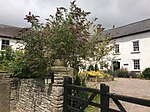
|
| Barn, Stable and Cider House at Great Tre-Rhew Farm | Llantilio Crossenny | 27 October 2000 | SO3776417734 51°51′17″N 2°54′18″W / 51.854735361231°N 2.9050322290758°W |
Barn, Stable & Cider House | Listing includes corn barn with attached stable and cider house, some 10m northeast of the farmhouse at Great Tre-Rhew[230] | 24302 | 
|
| Maerdy Farmhouse | Llanvihangel-Ystern-Llewern | 27 October 2000 | SO4353315011 51°49′51″N 2°49′15″W / 51.83087°N 2.82083°W |
Farmhouse | A Renaissance house extended from a late 17th-century farmhouse, approximately 4 km (2.5 mi) east of Llantilio Crossenny village, on a minor road from Onen to Newcastle[231] | 24311 | 
|
| High House | Penrhos | 27 October 2000 | SO4084012067 51°48′15″N 2°51′34″W / 51.80412°N 2.85941°W |
House | Renaissance style house dated 1675 approximately 3 km (1.9 mi) southeast of Llantilio Crossenny, at the end of a short drive which runs north off the minor road, some 500m southeast of Croes-y-gareg[232] | 24322 | 
|
| Upper White Castle Farmhouse | Llantilio Crossenny | 27 October 2000 | SO3805516670 51°50′43″N 2°54′02″W / 51.845202656795°N 2.9006166773739°W |
Farmhouse | On the west side of the minor road from Trerew to Llantilio Crossenny, located on gently sloping high ground approximately 100m southeast of White Castle[233] | 24332 | 
|
| Church of St Wonnow | Wonastow | 27 November 1953 | SO4856810793 51°47′36″N 2°44′50″W / 51.793437213595°N 2.7471484115722°W |
Church | About 2.5 km (1.6 mi) southwest of Monmouth, close to Wonastow Court on the south side of the minor road between Monmouth and Dingestow[234] | 24452 | 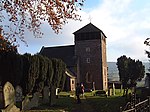
|
| Cefntilla Court | Raglan | 31 January 2001 | SO4057002917 51°43′19″N 2°51′42″W / 51.721837242423°N 2.861753221016°W |
House | In landscaped grounds some 1.5 km (0.93 mi) southwest of Llandenny down drive west of lane to Gwernesney and Usk[235] | 24741 | 
|
| Wyndcliffe Court | St Arvans | 14 February 2001 | ST5179897252 51°40′19″N 2°41′54″W / 51.671986296371°N 2.6984390306708°W |
House | On the west side of Penterry Lane about 400m north of the junction with Devauden Road[236] | 24763 | 
|
| Wyndcliffe Court, garden terracing, steps, pool, pergola and summerhouse | St Arvans | 14 February 2001 | ST5173997240 51°40′19″N 2°41′57″W / 51.671873331522°N 2.6992904827647°W |
Garden structure | Mostly to the south and west of Wyndcliffe Court[237] | 24764 | 
|
| Wyndcliffe Court, garage cottages | St Arvans | 14 February 2001 | ST5184697270 51°40′20″N 2°41′52″W / 51.672152252935°N 2.6977474590632°W |
House | About 50m east of Wyndcliffe Court on the north side of the entrance drive[238] | 24766 | 
|
| Bigsweir Bridge | Trellech | 28 February 2001 | SO5386705105 51°44′34″N 2°40′10″W / 51.74276302084°N 2.66956397713°W |
Bridge | On the eastern boundary of Trellech at the county boundary of Monmouthshire and Gloucestershire carrying the A466 over the River Wye[239] | 24916 | 
|
| Barn at Pant-glas Farm | Llanishen | 28 February 2001 | SO4820904126 51°44′00″N 2°45′05″W / 51.733465865375°N 2.7513572520685°W |
Barn | About 60m east of Pant-glas Farmhouse[240] | 24939 | 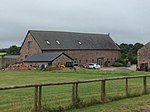
|
| Grange Farmhouse farm buildings | Newcastle | 19 March 2001 | SO4527016601 51°50′43″N 2°47′45″W / 51.84534°N 2.79588°W |
Farm buildings | An exceptionally complete complex of early 18th century farm buildings on the west side of the farmhouse, approximately 800m southeast of Newcastle, the farmhouse is listed Grade II[241] | 25039 | 
|
| Norton Court | Skenfrith | 19 March 2001 | SO4448820199 51°52′39″N 2°48′28″W / 51.87761°N 2.80781°W |
House | Substantial house dating from circa 1500 with original interior features, on the north side of the junction of two lanes approximately 1.2 km (0.75 mi) west of Skenfrith village[242] | 25046 | 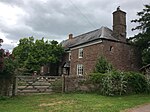
|
| Ty-asch | Mamhilad | 18 July 2001 | SO2993303467 51°43′32″N 3°00′57″W / 51.72555°N 3.01583°W |
House | A rare unaltered late C16th century two-cell house, about 650m west of the church of St Illtyd[243] | 25578 | 
|
| Upper Tal-y-fan | Dingestow | 27 September 2001 | SO4519108665 51°46′26″N 2°47′45″W / 51.773984697949°N 2.7957716424397°W |
House | About 1.8 km (1.1 mi) south-southwest of the church of St Dingat, on the east side of a farm track running off the old road between Mitchel Troy and Raglan where it bends under the A40(T)[244] | 25777 | 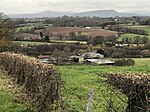
|
| Church of St Mary | Tregare | 27 September 2001 | SO4176910250 51°47′16″N 2°50′44″W / 51.787887573236°N 2.8456285737227°W |
Church | About 9 km (5.6 mi) west-southwest of Monmouth, on the west side of a northward bend in the minor road between Dingestow and Raglan[245] | 25787 | 
|
| 27 Old Market Street | Usk | 16 February 1953 | SO3766600572 51°42′02″N 2°54′12″W / 51.70044°N 2.90337°W |
House | Part of a long range[246] | 82730 | 
|
| Henllys | Usk | 30 April 2004 | SO3754900596 51°42′02″N 2°54′18″W / 51.70064°N 2.90506°W |
House | Part of a long range (with Ynys Hafod and Min Yr Afon) in the middle of the west side of New Market Street[247] | 82763 | 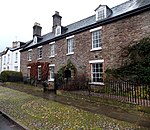
|
| Min Yr Afon | Usk | 30 April 2004 | SO3755000589 51°42′02″N 2°54′18″W / 51.70058°N 2.90505°W |
House | A long range (with Henllys and Ynys Hafod) in the middle of the west side of New Market Street[248] | 82767 | 
|
| 30 Bridge Street | Usk | 30 April 2004 | SO3749500787 51°42′08″N 2°54′21″W / 51.702353495435°N 2.9058803534433°W |
House | Listing pertains to the rear wing only[249] | 82772 | 
|
| Olde Malsters | Usk | 4 January 1974 | SO3753500696 51°42′06″N 2°54′19″W / 51.70154°N 2.90529°W |
House | A large house with medieval origins, at the top wide part of New Market Street, with a side elevation on passageway now leading to car-park adjacent to the museum[250] | 82780 | 
|
| Cornwall House | Monmouth | 27 June 1952 | SO5063512682 51°48′38″N 2°43′03″W / 51.810606566058°N 2.7174500600527°W |
House | On Monmouth's principal commercial street which leads out of the town square going southwest to Monnow Bridge[251] | 85142 | 
|
| 14 Church Street | Monmouth | 27 October 1965 | SO5082912927 51°48′46″N 2°42′53″W / 51.812826324712°N 2.7146711694721°W |
Commercial | In the street leading northeast out of the town square[252] | 85030 | 
|
| 16 Church Street | Monmouth | 27 October 1965 | SO5083312930 51°48′46″N 2°42′53″W / 51.812853648286°N 2.7146135780593°W |
Commercial | In the street leading northeast out of the town square[253] | 85038 | 
|
| 1 Priory Street | Monmouth | 27 June 1952 | SO5078512919 51°48′46″N 2°42′55″W / 51.812750520289°N 2.7153082300604°W |
Commercial | Part of the group on the principal street leading north and east from the town square[254] | 2320 | 
|
| 2 Priory Street | Monmouth | 27 June 1952 | SO5078512924 51°48′46″N 2°42′55″W / 51.812795471635°N 2.7153089419965°W |
Commercial | Part of the group on the principal street leading north and east from the town square[255] | 85057 | 
|
| 3 Priory Street | Monmouth | 27 June 1952 | SO5078712931 51°48′46″N 2°42′55″W / 51.812858580062°N 2.7152809296134°W |
Commercial | Part of the group on the principal street leading north and east from the town square[256] | 85096 | 
|
| 4 Priory Street | Monmouth | 27 June 1952 | SO5078812937 51°48′46″N 2°42′55″W / 51.812912609945°N 2.7152672793418°W |
Commercial | Part of the group on the principal street leading north and east from the town square[257] | 85123 | 
|
| 5 Priory Street | Monmouth | 27 June 1952 | SO5079312950 51°48′47″N 2°42′55″W / 51.813029924761°N 2.7151966072668°W |
Commercial | Part of the group on the principal street leading north and east from the town square[258] | 85135 | 
|
| 6 Priory Street | Monmouth | 27 June 1952 | SO5079512955 51°48′47″N 2°42′55″W / 51.813075052621°N 2.7151683098626°W |
Commercial | Part of the group on the principal street leading north and east from the town square[259] | 85148 | 
|
| Newton Court | Monmouth | 8 October 2005 | SO5228914327 51°49′32″N 2°41′37″W / 51.825539602248°N 2.693687800092°W |
House | About 1500m to the northeast of the town, accessed off the main road to Ross[260] | 85215 | 
|
| Redbrook Incline Bridge | Monmouth | 8 October 2005 | SO5366410270 51°47′21″N 2°40′24″W / 51.789181757076°N 2.6731945028765°W |
Bridge | At the south-eastern corner of Monmouth Community[261] | 85227 | 
|
| Gunter Mansion | Abergavenny | 5 July 1952 | SO3005114017 51°49′14″N 3°00′59″W / 51.82044°N 3.01626°W |
Commercial | Nos. 37 to 39 form a block with No. 40 Cross Street, the original building was a house dating to the late 1500s, refurbished and enlarged in the 1600s, No. 40 is no longer thought part of the mansion and is listed Grade II[262] Additional reference numbers:[263][264] |
86876 | 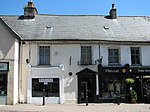
|
| Pant-y-Goitre Bridge | Llanfair Kilgeddin | 12 September 2005 | SO3482708916 51°46′30″N 2°56′46″W / 51.77512790175°N 2.9460072972445°W |
Bridge | Carries the main Usk-Abergavenny road over the River Usk about 250m north of Pant-y-Goitre crossroads[265] | 87210 | 
|
| Pentwyn | Rockfield | 28 September 2006 | SO4811614938 51°49′50″N 2°45′16″W / 51.83066°N 2.75432°W |
House | House improved by architect George Vaughan Maddox with good surviving Georgian interiors, it is located to the west of the B4347, about 100 metres northwest of Rockfield Church[266] | 87504 | 
|
See also
- Listed buildings in Wales
- Grade II* listed buildings in Herefordshire
- Grade II* listed buildings in Forest of Dean
- Grade II* listed buildings in Newport
- Grade II* listed buildings in Torfaen
- Grade II* listed buildings in Blaenau Gwent
- Grade II* listed buildings in Powys
- Grade I listed buildings in Monmouthshire
- List of Scheduled Monuments in Monmouthshire
Notes
- ^ There is not an exact match between the number of Grade II* listed buildings in Monmouthshire, (244), and the number of Wikipedia entries for these, (217). There are a number of reasons for this, including that some Wikipedia entries cover more than one listing, e.g. Castle Terrace, Chepstow covers thirteen listings, and that some single buildings or structures have more than one listing, e.g. New Bridge, Newbridge-on-Usk which, quite commonly for bridges, has listings for both ends.
- ^ Sometimes known as OSGB36, the grid reference is based on the British national grid reference system used by the Ordnance Survey.
References
- ^ Evans 1953, p. 29.
- ^ "Monmouthshire – History, Facts, & Points of Interest". Encyclopedia Britannica. Retrieved 30 July 2019.
- ^ "Monmouthshire Population". population.city. Retrieved 19 July 2019.
- ^ "Clause 256 (Hansard, 20 July 1972)". api.parliament.uk. HMSO. Retrieved 30 July 2019.
- ^ Clark 1979, p. 207.
- ^ Clark 1980, p. 42.
- ^ McCloy 2013, p. 126.
- ^ "Coflein". online database of RCAHMW. Royal Commission on the Ancient and Historical Monuments of Wales. Archived from the original on 27 November 2016. Retrieved 28 November 2016.
- ^ "Planning (Listed Buildings and Conservation Areas) Act 1990". The National Archives. Archived from the original on 24 January 2013. Retrieved 18 June 2013.
- ^ "What is Listing?". Historic England. Archived from the original on 2017-03-14. Retrieved 2019-07-19.
- ^ British Listed Buildings online. "Grade II* Listed Buildings in Monmouthshire". www.britishlistedbuildings.co.uk. Archived from the original on 2017-07-30. Retrieved 2017-07-30.
- ^ Courtney 2008, p. 53.
- ^ Kenyon 2010, p. 141.
- ^ Coxe 1995b, p. 331.
- ^ Newman 2000, p. 190.
- ^ Newman 2000, p. 471.
- ^ Newman 2000, p. 516.
- ^ Newman 2009, p. 332.
- ^ Newman 2000, p. 244.
- ^ Newman 2000, pp. 264–265.
- ^ Coxe 1995a, p. 159.
- ^ Lewis 2011, p. 116.
- ^ Newman 2000, p. 394.
- ^ Knight 2004, p. 277.
- ^ Newman 2000, pp. 265–266.
- ^ Newman 2000, p. 395.
- ^ Kissack 1975, p. 251.
- ^ Newman 2000, p. 408.
- ^ Newman 2000, p. 247.
- ^ Newman 2000, p. 402.
- ^ Hando 1954, p. 40.
- ^ Kissack 1986, p. 2.
- ^ Benson 2017, p. 4.
- ^ Newman 2000, p. 272.
- ^ Newman 2000, p. 208.
- ^ "Obituaries in 1897". Cricinfo. Wisden. November 24, 2005. Retrieved 1 September 2019.
- ^ Shipton, Martin (April 27, 2015). "Millionaire mansion owner admits illegal work on Grade II property". walesonline. Wales Online. Retrieved 1 September 2019.
- ^ Bradney 1991, preface.
- ^ Fox & Raglan 1994, preface.
- ^ Smith 1975, p. 7.
- ^ Newman 2000, p. 84.
- ^ Cadw. "Upper Dyffryn House (1922)". National Historic Assets of Wales. Retrieved 20 July 2019.
- ^ Cadw. "Old Court (1923)". National Historic Assets of Wales. Retrieved 20 July 2019.
- ^ Cadw. "Great Pool Hall (1924)". National Historic Assets of Wales. Retrieved 20 July 2019.
- ^ Cadw. "Llanarth Court (1925)". National Historic Assets of Wales. Retrieved 20 July 2019.
- ^ Cadw. "Wern-ddu Farmhouse (1927)". National Historic Assets of Wales. Retrieved 20 July 2019.
- ^ Cadw. "Court Farm and Court Farm Cottage (1928)". National Historic Assets of Wales. Retrieved 20 July 2019.
- ^ Cadw. "Trewyn House (1931)". National Historic Assets of Wales. Retrieved 20 July 2019.
- ^ Cadw. "Dovecote at Trewyn House (1932)". National Historic Assets of Wales. Retrieved 20 July 2019.
- ^ Cadw. "Little Llwygy Farmhouse (1936)". National Historic Assets of Wales. Retrieved 20 July 2019.
- ^ Cadw. "Garden House at Llanvihangel Court (1945)". National Historic Assets of Wales. Retrieved 20 July 2019.
- ^ Cadw. "Lower Dyffryn House (1950)". National Historic Assets of Wales. Retrieved 20 July 2019.
- ^ Cadw. "Glyndwr including railed forecourt (1952)". National Historic Assets of Wales. Retrieved 20 July 2019.
- ^ Cadw. "Town Farm (1953)". National Historic Assets of Wales. Retrieved 20 July 2019.
- ^ Cadw. "Lower Tresenny Barn (1954)". National Historic Assets of Wales. Retrieved 20 July 2019.
- ^ Cadw. "Church of St James, Llangua (1958)". National Historic Assets of Wales. Retrieved 20 July 2019.
- ^ Cadw. "Lower Celliau (1960)". National Historic Assets of Wales. Retrieved 2 August 2019.
- ^ Cadw. "Church of St Peter, Bryngwyn (1964)". National Historic Assets of Wales. Retrieved 2 August 2019.
- ^ Cadw. "Chapel Farmhouse (1965)". National Historic Assets of Wales. Retrieved 2 August 2019.
- ^ Cadw. "Gateway and railings to Clytha Park (1967)". National Historic Assets of Wales. Retrieved 2 August 2019.
- ^ Cadw. "Church of Saint Teilo, Llanarth (1969)". National Historic Assets of Wales. Retrieved 2 August 2019.
- ^ Cadw. "Church of St Mary and St Michael, Llanarth (1971)". National Historic Assets of Wales. Retrieved 2 August 2019.
- ^ Cadw. "Little Pitt Cottage (1974)". National Historic Assets of Wales. Retrieved 2 August 2019.
- ^ Cadw. "Church of St Mapley/Mabli, Llanvapley (1976)". National Historic Assets of Wales. Retrieved 2 August 2019.
- ^ Cadw. "Llanwenarth House (1977)". National Historic Assets of Wales. Retrieved 2 August 2019.
- ^ Cadw. "Church of St Peter, Llanwenarth (1980)". National Historic Assets of Wales. Retrieved 2 August 2019.
- ^ Cadw. "Church of St Cadoc, Llangattock-juxta-Usk (1988)". National Historic Assets of Wales. Retrieved 2 August 2019.
- ^ Cadw. "Llangattock Court (1990)". National Historic Assets of Wales. Retrieved 2 August 2019.
- ^ Cadw. "Church of St Bartholomew, Llanover (1992)". National Historic Assets of Wales. Retrieved 2 August 2019.
- ^ Cadw. "Church of St Michael, Llanvihangel Gobion (1998)". National Historic Assets of Wales. Retrieved 2 August 2019.
- ^ Cadw. "Blaengavenny Farmhouse (2003)". National Historic Assets of Wales. Retrieved 2 August 2019.
- ^ Cadw. "Moynes Court (2008)". National Historic Assets of Wales. Retrieved 2 August 2019.
- ^ Cadw. "St Pierre Hotel Gatehouse (2010)". National Historic Assets of Wales. Retrieved 2 August 2019.
- ^ Cadw. "Piercefield House (2013)". National Historic Assets of Wales. Retrieved 2 August 2019.
- ^ Cadw. "West Pavilion, Piercefield House (24754)". National Historic Assets of Wales. Retrieved 2 August 2019.
- ^ Cadw. "East Pavilion, Piercefield House (24755)". National Historic Assets of Wales. Retrieved 2 August 2019.
- ^ Cadw. "Church of St Stephen and St Tathan (2014)". National Historic Assets of Wales. Retrieved 2 August 2019.
- ^ Cadw. "Church of St Michael, Llanfihangel Tor-y-Mynydd (2020)". National Historic Assets of Wales. Retrieved 2 August 2019.
- ^ Cadw. "Church of St Thomas à Becket, Wolvesnewton (2023)". National Historic Assets of Wales. Retrieved 2 August 2019.
- ^ Cadw. "Churchyard cross at the Church of St Thomas à Becket, Wolvesnewton (2024)". National Historic Assets of Wales. Retrieved 2 August 2019.
- ^ Cadw. "Church of the Holy Cross, Kilgwrrwg (2025)". National Historic Assets of Wales. Retrieved 2 August 2019.
- ^ Cadw. "Allt-y-Bela (2031)". National Historic Assets of Wales. Retrieved 2 August 2019.
- ^ Cadw. "Cwrt y Brychan barn, stable and granary (2033)". National Historic Assets of Wales. Retrieved 2 August 2019.
- ^ Cadw. "Church of St Michael and All Angels, Llanfihangel Rogiet (2035)". National Historic Assets of Wales. Retrieved 2 August 2019.
- ^ Cadw. "Manor Farmhouse (2038)". National Historic Assets of Wales. Retrieved 2 August 2019.
- ^ Cadw. "Moynes Court Gatehouse (2042)". National Historic Assets of Wales. Retrieved 2 August 2019.
- ^ Cadw. "Church of St Mary, Rogiet (2047)". National Historic Assets of Wales. Retrieved 2 August 2019.
- ^ Cadw. "Howick Farmhouse (2049)". National Historic Assets of Wales. Retrieved 2 August 2019.
- ^ Cadw. "St Anne's House (2051)". National Historic Assets of Wales. Retrieved 2 August 2019.
- ^ Cadw. "Church Farmhouse, Caldicot (2055)". National Historic Assets of Wales. Retrieved 2 August 2019.
- ^ Cadw. "Great Killough (2056)". National Historic Assets of Wales. Retrieved 2 August 2019.
- ^ Cadw. "The Pant (2057)". National Historic Assets of Wales. Retrieved 2 August 2019.
- ^ Cadw. "Trivor Farmhouse (2058)". National Historic Assets of Wales. Retrieved 2 August 2019.
- ^ Cadw. "Hilston Park (2059)". National Historic Assets of Wales. Retrieved 2 August 2019.
- ^ Cadw. "Troy House (2060)". National Historic Assets of Wales. Retrieved 2 August 2019.
- ^ Cadw. "Dingestow Court (2061)". National Historic Assets of Wales. Retrieved 2 August 2019.
- ^ Cadw. "Llwyn-y-gaer House (2062)". National Historic Assets of Wales. Retrieved 2 August 2019.
- ^ Cadw. "The Artha (2063)". National Historic Assets of Wales. Retrieved 2 August 2019.
- ^ Cadw. "Old Trecastle Farmhouse (2066)". National Historic Assets of Wales. Retrieved 2 August 2019.
- ^ Cadw. "Treworgan Manor (2067)". National Historic Assets of Wales. Retrieved 2 August 2019.
- ^ Cadw. "Hygga House Dovecote (2071)". National Historic Assets of Wales. Retrieved 2 August 2019.
- ^ Cadw. "Church of St Michael and All Angels, Llanvihangel-Ystern-Llewern (2072)". National Historic Assets of Wales. Retrieved 2 August 2019.
- ^ Cadw. "Brynderi House (2074)". National Historic Assets of Wales. Retrieved 2 August 2019.
- ^ Cadw. "Croft Farm Barn (2077)". National Historic Assets of Wales. Retrieved 2 August 2019.
- ^ Cadw. "Upper Green (2078)". National Historic Assets of Wales. Retrieved 2 August 2019.
- ^ Cadw. "Skenfrith Castle (2083)". National Historic Assets of Wales. Retrieved 2 August 2019.
- ^ Cadw. "Church of St Maughan, Llangattock Vibon Avel (2084)". National Historic Assets of Wales. Retrieved 2 August 2019.
- ^ Cadw. "Church of St Michael and All Angels, Mitchel Troy (2086)". National Historic Assets of Wales. Retrieved 2 August 2019.
- ^ Cadw. "The Pwll (2090)". National Historic Assets of Wales. Retrieved 2 August 2019.
- ^ Cadw. "Ty Mawr (2092)". National Historic Assets of Wales. Retrieved 2 August 2019.
- ^ Cadw. "Ty Mawr Gatehouse (2093)". National Historic Assets of Wales. Retrieved 2 August 2019.
- ^ Cadw. "Pen-y-clawdd Farmhouse (2099)". National Historic Assets of Wales. Retrieved 2 August 2019.
- ^ Cadw. "Church of St Cadoc, Raglan (2100)". National Historic Assets of Wales. Retrieved 2 August 2019.
- ^ Cadw. "Pant-glas Farmhouse (2103)". National Historic Assets of Wales. Retrieved 2 August 2019.
- ^ Cadw. "Usk Bridge (2129)". National Historic Assets of Wales. Retrieved 2 August 2019.
- ^ Cadw. "Usk Sessions House (2154)". National Historic Assets of Wales. Retrieved 2 August 2019.
- ^ Cadw. "Usk Prison (21555)". National Historic Assets of Wales. Retrieved 2 August 2019.
- ^ Cadw. "Ynys Hafod (2169)". National Historic Assets of Wales. Retrieved 2 August 2019.
- ^ Cadw. "Porth-y-carn (2189)". National Historic Assets of Wales. Retrieved 2 August 2019.
- ^ Cadw. "Church of St Thomas the Martyr, Monmouth (2214)". National Historic Assets of Wales. Retrieved 2 August 2019.
- ^ Cadw. "Church of St Peter, Dixton (2215)". National Historic Assets of Wales. Retrieved 2 August 2019.
- ^ Cadw. "Clawdd-du (2219)". National Historic Assets of Wales. Retrieved 2 August 2019.
- ^ Cadw. "The Kymin Roundhouse (2222)". National Historic Assets of Wales. Retrieved 2 August 2019.
- ^ Cadw. "Agincourt House (2223)". National Historic Assets of Wales. Retrieved 2 August 2019.
- ^ Cadw. "Beaufort Arms Hotel (2227)". National Historic Assets of Wales. Retrieved 2 August 2019.
- ^ Cadw. "Statue of Charles Rolls (2229)". National Historic Assets of Wales. Retrieved 2 August 2019.
- ^ Cadw. "Kings Head Hotel (2230)". National Historic Assets of Wales. Retrieved 2 August 2019.
- ^ Cadw. "Former County Club, now part of the hotel (85171)". National Historic Assets of Wales. Retrieved 2 August 2019.
- ^ Cadw. "9 Agincourt Street (2242)". National Historic Assets of Wales. Retrieved 2 August 2019.
- ^ Cadw. "12–16 Church Street (2253)". National Historic Assets of Wales. Retrieved 2 August 2019.
- ^ Cadw. "Glendower House (2272)". National Historic Assets of Wales. Retrieved 2 August 2019.
- ^ Cadw. "Royal George House (2282)". National Historic Assets of Wales. Retrieved 2 August 2019.
- ^ Cadw. "Lord Nelson's Seat (2290)". National Historic Assets of Wales. Retrieved 2 August 2019.
- ^ Cadw. "Railings and gates at Cornwall House (2293)". National Historic Assets of Wales. Retrieved 2 August 2019.
- ^ Cadw. "Robin Hood Inn (2297)". National Historic Assets of Wales. Retrieved 2 August 2019.
- ^ Cadw. "Chapel House (2309)". National Historic Assets of Wales. Retrieved 2 August 2019.
- ^ Cadw. "Old Nag's Head Inn (2312)". National Historic Assets of Wales. Retrieved 2 August 2019.
- ^ Cadw. "Market Hall (2318)". National Historic Assets of Wales. Retrieved 2 August 2019.
- ^ Cadw. "White Swan Inn (2321)". National Historic Assets of Wales. Retrieved 2 August 2019.
- ^ Cadw. "Monmouth Priory (2323)". National Historic Assets of Wales. Retrieved 2 August 2019.
- ^ Cadw. "Monmouth Methodist Church (2342)". National Historic Assets of Wales. Retrieved 2 August 2019.
- ^ Cadw. "Tithe Barn, Abergavenny (2375)". National Historic Assets of Wales. Retrieved 2 August 2019.
- ^ Cadw. "Abergavenny Bridge (2378)". National Historic Assets of Wales. Retrieved 2 August 2019.
- ^ Cadw. "Abergavenny Bridge, also known as Usk Bridge (86902)". National Historic Assets of Wales. Retrieved 2 August 2019.
- ^ Cadw. "Church of Our Lady and St Michael (RC) (2467)". National Historic Assets of Wales. Retrieved 2 August 2019.
- ^ Cadw. "St John's Masonic Lodge (2470)". National Historic Assets of Wales. Retrieved 2 August 2019.
- ^ Cadw. "Raglan Lodge (2501)". National Historic Assets of Wales. Retrieved 2 August 2019.
- ^ Cadw. "14 Beaufort Square (2502)". National Historic Assets of Wales. Retrieved 2 August 2019.
- ^ Cadw. "Castle Terrace, Chepstow (2520)". National Historic Assets of Wales. Retrieved 2 August 2019.
- ^ Cadw. "Powis Almshouses (2524)". National Historic Assets of Wales. Retrieved 2 August 2019.
- ^ Cadw. "Church of St Illtyd, Mamhilad (2612)". National Historic Assets of Wales. Retrieved 2 August 2019.
- ^ Cadw. "Persondy (2619)". National Historic Assets of Wales. Retrieved 2 August 2019.
- ^ Cadw. "Ty-Cooke Farmhouse (2623)". National Historic Assets of Wales. Retrieved 2 August 2019.
- ^ Cadw. "Church of All Saints, Kemeys Commander (2626)". National Historic Assets of Wales. Retrieved 2 August 2019.
- ^ Cadw. "Church Farmhouse (2629)". National Historic Assets of Wales. Retrieved 2 August 2019.
- ^ Cadw. "Church of St David, Trostrey (2630)". National Historic Assets of Wales. Retrieved 2 August 2019.
- ^ Cadw. "Trostrey Court (2641)". National Historic Assets of Wales. Retrieved 2 August 2019.
- ^ Cadw. "Church of St Madoc, Llanbadoc (2651)". National Historic Assets of Wales. Retrieved 2 August 2019.
- ^ Cadw. "Church of St Cybi, Llangybi (2669)". National Historic Assets of Wales. Retrieved 2 August 2019.
- ^ Cadw. "Llandewi Court (2676)". National Historic Assets of Wales. Retrieved 2 August 2019.
- ^ Cadw. "New House Farm (2680)". National Historic Assets of Wales. Retrieved 2 August 2019.
- ^ Cadw. "Ton Farmhouse (2686)". National Historic Assets of Wales. Retrieved 2 August 2019.
- ^ Cadw. "White Hart Inn (2688)". National Historic Assets of Wales. Retrieved 2 August 2019.
- ^ Cadw. "Church of St Andrew, Tredunnock (2689)". National Historic Assets of Wales. Retrieved 2 August 2019.
- ^ Cadw. "Berllan-deg (2691)". National Historic Assets of Wales. Retrieved 2 August 2019.
- ^ Cadw. "Glen Usk (2697)". National Historic Assets of Wales. Retrieved 2 August 2019.
- ^ Cadw. "The Cwm (2710)". National Historic Assets of Wales. Retrieved 2 August 2019.
- ^ Cadw. "Nantybanw (2716)". National Historic Assets of Wales. Retrieved 2 August 2019.
- ^ Cadw. "Pentwyn, Llanllowell (2717)". National Historic Assets of Wales. Retrieved 2 August 2019.
- ^ Cadw. "Mathern Mill (2732)". National Historic Assets of Wales. Retrieved 2 August 2019.
- ^ Cadw. "Great Tresenny Farmhouse (2763)". National Historic Assets of Wales. Retrieved 2 August 2019.
- ^ Cadw. "Manor Farmhouse and Cottage (2768)". National Historic Assets of Wales. Retrieved 2 August 2019.
- ^ Cadw. "The Hendre (2773)". National Historic Assets of Wales. Retrieved 2 August 2019.
- ^ Cadw. "Walls, railings, gates and gate piers at the Church of St Mary, Monmouth (2780)". National Historic Assets of Wales. Retrieved 2 August 2019.
- ^ Cadw. "Priory Church of St Mary, Monmouth (2784)". National Historic Assets of Wales.
- ^ Cadw. "Great House, Llanover (2785)". National Historic Assets of Wales. Retrieved 2 August 2019.
- ^ Cadw. "Tal-y-coed Court (2787)". National Historic Assets of Wales.
- ^ Cadw. "Savoy Theatre (2812)". National Historic Assets of Wales. Retrieved 2 August 2019.
- ^ Cadw. "High Glanau (2813)". National Historic Assets of Wales. Retrieved 2 August 2019.
- ^ Cadw. "Garden terraces at High Glanau House (2814)". National Historic Assets of Wales. Retrieved 2 August 2019.
- ^ Cadw. "Bridges Community Centre (2852)". National Historic Assets of Wales. Retrieved 2 August 2019.
- ^ Cadw. "Upper Red House (2855)". National Historic Assets of Wales. Retrieved 2 August 2019.
- ^ Cadw. "Swiss Cottage (2857)". National Historic Assets of Wales. Retrieved 2 August 2019.
- ^ Cadw. "Millbrook (2858)". National Historic Assets of Wales. Retrieved 2 August 2019.
- ^ Cadw. "Newhouse Farm (2862)". National Historic Assets of Wales. Retrieved 2 August 2019.
- ^ Cadw. "Coed-y-gelli (2866)". National Historic Assets of Wales. Retrieved 2 August 2019.
- ^ Cadw. "Tregeiriog House (2855)". National Historic Assets of Wales. Retrieved 2 August 2019.
- ^ Cadw. "Walled garden at Troy House (2886)". National Historic Assets of Wales. Retrieved 2 August 2019.
- ^ Cadw. "The Argoed (2892)". National Historic Assets of Wales. Retrieved 2 August 2019.
- ^ Cadw. "Court Farmhouse, Llanthony (2895)". National Historic Assets of Wales. Retrieved 2 August 2019.
- ^ Cadw. "Grove Farm House (2898)". National Historic Assets of Wales. Retrieved 2 August 2019.
- ^ Cadw. "Church of St Elli, Llanelly (6665)". National Historic Assets of Wales. Retrieved 2 August 2019.
- ^ Cadw. "Clydach House (6667)". National Historic Assets of Wales. Retrieved 2 August 2019.
- ^ Cadw. "Burton's, Abergavenny (14875)". National Historic Assets of Wales. Retrieved 2 August 2019.
- ^ Cadw. "Llanwenarth Baptist Chapel (14933)". National Historic Assets of Wales. Retrieved 2 August 2019.
- ^ Cadw. "Ty-Hunt-y-Bwlch Farmhouse (15659)". National Historic Assets of Wales. Retrieved 2 August 2019.
- ^ Cadw. "The Old Cottage, Tredam (15761)". National Historic Assets of Wales. Retrieved 2 August 2019.
- ^ Cadw. "The Procurator's House, Magor (16064)". National Historic Assets of Wales. Retrieved 2 August 2019.
- ^ Cadw. "Cwm Bwchel Farmhouse (16277)". National Historic Assets of Wales. Retrieved 2 August 2019.
- ^ Cadw. "Church of St David, Llanddewwi Rhydderch (17417)". National Historic Assets of Wales. Retrieved 2 August 2019.
- ^ Cadw. "Church of St Bride, Llansantffraed (17419)". National Historic Assets of Wales. Retrieved 2 August 2019.
- ^ Cadw. "Church of St Cadoc, Penrhos (17421)". National Historic Assets of Wales. Retrieved 2 August 2019.
- ^ Cadw. "Church of St Cadoc, Llangattock Vibon Avel (17422)". National Historic Assets of Wales. Retrieved 2 August 2019.
- ^ Cadw. "Church of St Dingat, Dingestow (17424)". National Historic Assets of Wales. Retrieved 2 August 2019.
- ^ Cadw. "Church of St Govan, Llangovan (17426)". National Historic Assets of Wales. Retrieved 2 August 2019.
- ^ Cadw. "Church of St Martin, Pen-y-clawdd (17427)". National Historic Assets of Wales. Retrieved 2 August 2019.
- ^ Cadw. "Ty-mawr Farmhouse (18111)". National Historic Assets of Wales. Retrieved 2 August 2019.
- ^ Cadw. "Church of St Catwg, Cwmcarvan (18286)". National Historic Assets of Wales. Retrieved 2 August 2019.
- ^ Cadw. "Church of St Oudoceus, Llandogo (18575)". National Historic Assets of Wales. Retrieved 2 August 2019.
- ^ Cadw. "Barn at Trewyn Farm (19246)". National Historic Assets of Wales. Retrieved 2 August 2019.
- ^ Cadw. "Tabernacle Baptist Chapel, Cwmyoy (19257)". National Historic Assets of Wales. Retrieved 2 August 2019.
- ^ Cadw. "Terrace and garden walls, steps, gates and gatepiers at Trewyn House (19260)". National Historic Assets of Wales. Retrieved 2 August 2019.
- ^ Cadw. "Great House, Llanarth (22999)". National Historic Assets of Wales. Retrieved 2 August 2019.
- ^ Cadw. "Pwllyrhwyad (23012)". National Historic Assets of Wales. Retrieved 2 August 2019.
- ^ Cadw. "Grottoes and garden at Dewstow House (23059)". National Historic Assets of Wales. Retrieved 2 August 2019.
- ^ Cadw. "New Bridge, Newbridge-on-Usk (23490)". National Historic Assets of Wales. Retrieved 2 August 2019.
- ^ Cadw. "Listing for the alternate end of New Bridge (2704)". National Historic Assets of Wales. Retrieved 2 August 2019.
- ^ Cadw. "Ty-uchaf Farmhouse (23804)". National Historic Assets of Wales. Retrieved 2 August 2019.
- ^ Cadw. "Smart's Bridge (23813)". National Historic Assets of Wales. Retrieved 2 August 2019.
- ^ Cadw. "Embankment and aqueduct of the Brecon and Abergavenny Canal (23826)". National Historic Assets of Wales. Retrieved 2 August 2019.
- ^ Cadw. "Itton Court (23971)". National Historic Assets of Wales. Retrieved 2 August 2019.
- ^ Cadw. "Tredean House (23978)". National Historic Assets of Wales. Retrieved 2 August 2019.
- ^ Cadw. "Mounton House (24061)". National Historic Assets of Wales. Retrieved 2 August 2019.
- ^ Cadw. "Wyelands (24100)". National Historic Assets of Wales. Retrieved 2 August 2019.
- ^ Cadw. "Howell's House (24134)". National Historic Assets of Wales. Retrieved 2 August 2019.
- ^ Cadw. "Kitchen and dairy at Upper Dyffryn House (24150)". National Historic Assets of Wales. Retrieved 2 August 2019.
- ^ Cadw. "Great House Farm (24177)". National Historic Assets of Wales. Retrieved 2 August 2019.
- ^ Cadw. "Sleath Farmhouse (24180)". National Historic Assets of Wales. Retrieved 2 August 2019.
- ^ Cadw. "Gelli Farmhouse (24196)". National Historic Assets of Wales. Retrieved 2 August 2019.
- ^ Cadw. "Barn, stable and cider house at Great Tre-Rhew Farm (24302)". National Historic Assets of Wales. Retrieved 2 August 2019.
- ^ Cadw. "Maerdy Farmhouse (24311)". National Historic Assets of Wales. Retrieved 2 August 2019.
- ^ Cadw. "High House, Penrhos (24322)". National Historic Assets of Wales. Retrieved 2 August 2019.
- ^ Cadw. "Upper White Castle Farmhouse (24332)". National Historic Assets of Wales. Retrieved 2 August 2019.
- ^ Cadw. "Church of St Wonnow, Wonastow (24452)". National Historic Assets of Wales. Retrieved 2 August 2019.
- ^ Cadw. "Cefntilla Court (24741)". National Historic Assets of Wales. Retrieved 2 August 2019.
- ^ Cadw. "Wyndcliffe Court (24763)". National Historic Assets of Wales. Retrieved 2 August 2019.
- ^ Cadw. "Terracing, steps, pool, pergola and summerhouse at Wyndcliffe Court (24764)". National Historic Assets of Wales. Retrieved 2 August 2019.
- ^ Cadw. "Garage cottages at Wyndcliffe Court (24766)". National Historic Assets of Wales. Retrieved 2 August 2019.
- ^ Cadw. "Bigsweir Bridge (24916)". National Historic Assets of Wales. Retrieved 2 August 2019.
- ^ Cadw. "Barn at Pant-glas Farmhouse (24939)". National Historic Assets of Wales. Retrieved 2 August 2019.
- ^ Cadw. "Farm buildings at Grange Farm (25039)". National Historic Assets of Wales. Retrieved 2 August 2019.
- ^ Cadw. "Norton Court (25046)". National Historic Assets of Wales. Retrieved 2 August 2019.
- ^ Cadw. "Ty-asch (25578)". National Historic Assets of Wales. Retrieved 2 August 2019.
- ^ Cadw. "Upper Tal-y-fan (25777)". National Historic Assets of Wales. Retrieved 2 August 2019.
- ^ Cadw. "Church of St Mary, Tregare (25787)". National Historic Assets of Wales. Retrieved 2 August 2019.
- ^ Cadw. "27 Old Market Street, Usk (82730)". National Historic Assets of Wales. Retrieved 2 August 2019.
- ^ Cadw. "Henllys (82763)". National Historic Assets of Wales. Retrieved 2 August 2019.
- ^ Cadw. "Min Yr Afon (82767)". National Historic Assets of Wales. Retrieved 2 August 2019.
- ^ Cadw. "30 Bridge Street, Usk (82772)". National Historic Assets of Wales. Retrieved 2 August 2019.
- ^ Cadw. "Olde Malsters (82780)". National Historic Assets of Wales. Retrieved 2 August 2019.
- ^ Cadw. "Cornwall House (85142)". National Historic Assets of Wales. Retrieved 2 August 2019.
- ^ Cadw. "14 Church Street, Monmouth (85030)". National Historic Assets of Wales. Retrieved 2 August 2019.
- ^ Cadw. "16 Church Street, Monmouth (85038)". National Historic Assets of Wales. Retrieved 2 August 2019.
- ^ Cadw. "1 Priory Street, Monmouth (2320)". National Historic Assets of Wales. Retrieved 2 August 2019.
- ^ Cadw. "2 Priory Street, Monmouth (85057)". National Historic Assets of Wales. Retrieved 2 August 2019.
- ^ Cadw. "3 Priory Street, Monmouth (85096)". National Historic Assets of Wales. Retrieved 2 August 2019.
- ^ Cadw. "4 Priory Street, Monmouth (85123)". National Historic Assets of Wales. Retrieved 2 August 2019.
- ^ Cadw. "5 Priory Street, Monmouth (85135)". National Historic Assets of Wales. Retrieved 2 August 2019.
- ^ Cadw. "6 Priory Street, Monmouth (85148)". National Historic Assets of Wales. Retrieved 2 August 2019.
- ^ Cadw. "Newton Court (85215)". National Historic Assets of Wales. Retrieved 2 August 2019.
- ^ Cadw. "Redbrook Incline Bridge (85227)". National Historic Assets of Wales. Retrieved 2 August 2019.
- ^ Cadw. "Gunter Mansion, 37 Cross Street (86876)". National Historic Assets of Wales. Retrieved 2 August 2019.
- ^ Cadw. "38 Cross Street (2404)". National Historic Assets of Wales. Retrieved 2 August 2019.
- ^ Cadw. "39 Cross Street (86877)". National Historic Assets of Wales. Retrieved 2 August 2019.
- ^ Cadw. "Pant-y-Goitre Bridge (87210)". National Historic Assets of Wales. Retrieved 2 August 2019.
- ^ Cadw. "Pentwyn House (87504)". National Historic Assets of Wales. Retrieved 2 August 2019.
Sources
- Benson, Ann (2017). Troy House – A Tudor Estate Across Time. Cardiff: University of Wales Press. ISBN 978-1-7831-6989-4.
{{cite book}}: CS1 maint: ref duplicates default (link) - Bradney, Joseph (1991) [1904]. A History of Monmouthshire: The Hundred of Skenfrith, Volume 1 Part 1. London: Academy Books. ISBN 978-1-8733-6109-2.
{{cite book}}: CS1 maint: ref duplicates default (link) - Clark, Arthur (1980). The Story of Monmouthshire, Volume 1, From the earliest times to the Civil War. Monmouth: Monnow Press. ISBN 978-0-9506-6181-0.
{{cite book}}: CS1 maint: ref duplicates default (link) - Clark, Arthur (1979). The Story of Monmouthshire, Volume 2, From the Civil War to Present Times. Monmouth: Monnow Press. ISBN 978-0-9506-6180-3.
{{cite book}}: Unknown parameter|authormask=ignored (|author-mask=suggested) (help)CS1 maint: ref duplicates default (link) - Courtney, Paul (2008). Griffiths, Ralph A.; Hopkins, Tony; Howell, Ray (eds.). The Age of the Marcher Lords, c.1070–1536. The Gwent County History. Vol. 2. Cardiff: University of Wales Press. ISBN 978-0-7083-2072-3.
{{cite book}}: Unknown parameter|editor1link=ignored (|editor-link1=suggested) (help)CS1 maint: ref duplicates default (link) - Coxe, William (1995) [1801]. An Historical Tour of Monmouthshire: Volume 1. Cardiff: Merton Priory Press. ISBN 978-1-8989-3709-8.
- Coxe, William (1995) [1801]. An Historical Tour of Monmouthshire: Volume 2. Cardiff: Merton Priory Press. ISBN 978-1-8989-3708-1.
{{cite book}}: Unknown parameter|authormask=ignored (|author-mask=suggested) (help) - Evans, Cyril James Oswald (1953). Monmouthshire: Its History and Topography. Cardiff: William Lewis Printers. OCLC 2415203.
{{cite book}}: CS1 maint: ref duplicates default (link) - Fox, Cyril; Raglan, Lord (1994) [1951]. Medieval Houses. Monmouthshire Houses. Vol. 1. Cardiff: Merton Priory Press Ltd & The National Museum of Wales. ISBN 978-0-7200-0396-3.
{{cite book}}: CS1 maint: ref duplicates default (link) - Hando, Fred (1954). Monmouthshire Sketch Book. Newport: R. H. Johns Ltd. OCLC 30166792.
{{cite book}}: CS1 maint: ref duplicates default (link) - Kenyon, John (2010). The Medieval Castles of Wales. Cardiff: University of Wales Press. ISBN 978-0-7083-2180-5.
{{cite book}}: CS1 maint: ref duplicates default (link) - Kissack, Keith (1975). Monmouth: The Making of a County Town. Chichester: Phillimore. OCLC 255539468.
{{cite book}}: CS1 maint: ref duplicates default (link) - Kissack, Keith (1986). Victorian Monmouth. Ledbury: Monmouth Historical and Education Trust. ISBN 0950338621.
{{cite book}}: Unknown parameter|authormask=ignored (|author-mask=suggested) (help)CS1 maint: ref duplicates default (link) - Knight, Jeremy (2004). Howell, Ray; Aldhouse-Green, Miranda; Griffiths, Ralph A. (eds.). Gwent in Prehistory and Early History. The Gwent County History. Vol. 1. Cardiff: University of Wales Press. ISBN 978-0-7083-1826-3.
{{cite book}}: Unknown parameter|editor3link=ignored (|editor-link3=suggested) (help)CS1 maint: ref duplicates default (link) - Lewis, C. Roy (2011). Williams, Chris; Williams, Sian Rhiannon; Griffiths, Ralph A. (eds.). Industrial Monmouthshire, c.1780–1914. The Gwent County History. Vol. 4. Cardiff: University of Wales Press. ISBN 978-0-7083-2365-6.
{{cite book}}: Unknown parameter|editor3link=ignored (|editor-link3=suggested) (help)CS1 maint: ref duplicates default (link) - McCloy, Robert (2013). Williams, Chris; Croll, Andy; Griffiths, Ralph A. (eds.). The Twentieth Century. The Gwent County History. Vol. 5. Cardiff: University of Wales Press. ISBN 978-0-7083-2648-0.
{{cite book}}: Unknown parameter|editor3link=ignored (|editor-link3=suggested) (help)CS1 maint: ref duplicates default (link) - Newman, John (2000). Gwent/Monmouthshire. The Buildings of Wales. London: Penguin. ISBN 978-0-3000-9630-9.
{{cite book}}: CS1 maint: ref duplicates default (link) - Newman, John (2009). Gray, Madeleine; Morgan, Prys; Griffiths, Ralph A. (eds.). The Making of Monmouthshire, c.1536–1780. The Gwent County History. Vol. 3. Cardiff: University of Wales Press. ISBN 978-0-7083-2198-0.
{{cite book}}: Unknown parameter|editor3link=ignored (|editor-link3=suggested) (help)CS1 maint: ref duplicates default (link) - Smith, Peter (1975). Houses of the Welsh Countryside. London: Her Majesty's Stationery Office. ISBN 978-0-1170-0475-7.
{{cite book}}: CS1 maint: ref duplicates default (link)

